#zaragoza spain best restaurants
Explore tagged Tumblr posts
Text
Plan Your Perfect Trip with this Zaragoza, Spain Travel Guide
Discover the hidden gem of Zaragoza, Spain. Immerse yourself in its fascinating history and explore its stunning architecture and rich cultural tradition with this comprehensive travel guide.
This Zaragoza, Spain travel guide post contains my Hotels.com, Expedia, Vrbo, and Viator affiliate links. I may receive a commission when you book a hotel or tour from this article, though at no additional cost to you. I hand-pick and recommend only the hotels and tours that I have thoroughly researched and feel comfortable recommending. While other cities in Spain may get more attention from…

View On WordPress
#zaragoza spain accommodation#zaragoza spain airport#zaragoza spain attractions#zaragoza spain best restaurants#zaragoza spain cathedral#zaragoza spain day trips#zaragoza spain directions#zaragoza spain food#zaragoza spain from madrid#zaragoza spain hotels#zaragoza spain images#zaragoza spain map#zaragoza spain must see#zaragoza spain nearest airport#zaragoza spain on a map#zaragoza spain on map#zaragoza spain photos#zaragoza spain places to visit#zaragoza spain restaurants#zaragoza spain sights#zaragoza spain temperature#zaragoza spain things to do#zaragoza spain to do#zaragoza spain to madrid#zaragoza spain tourism#zaragoza spain tourist attractions#zaragoza spain travel#zaragoza spain travel guide#zaragoza spain visit#zaragoza spain what to do
0 notes
Text
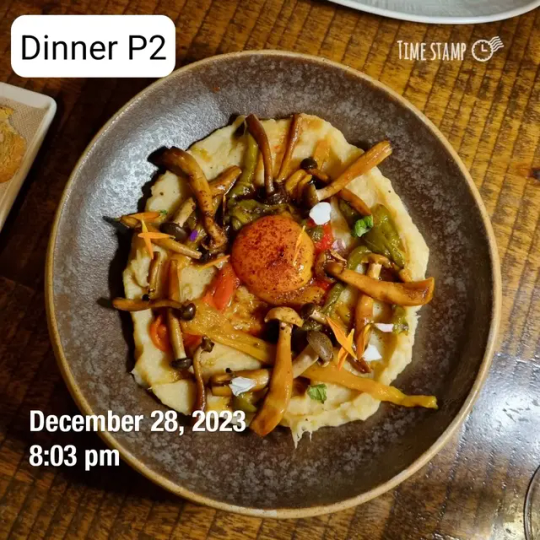
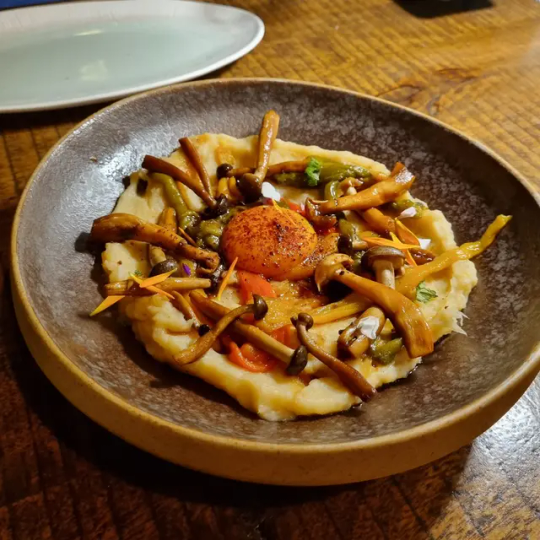

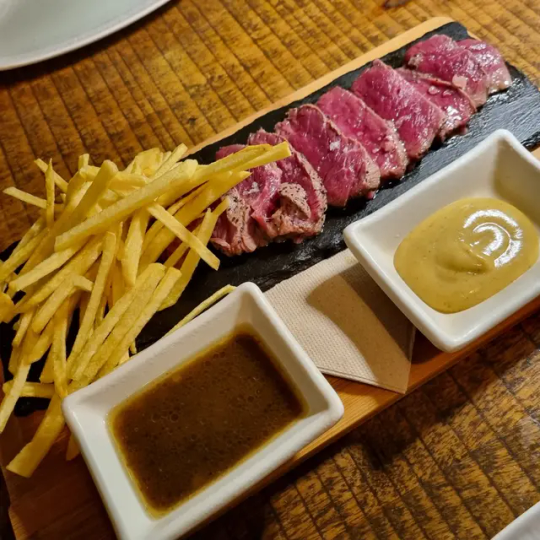
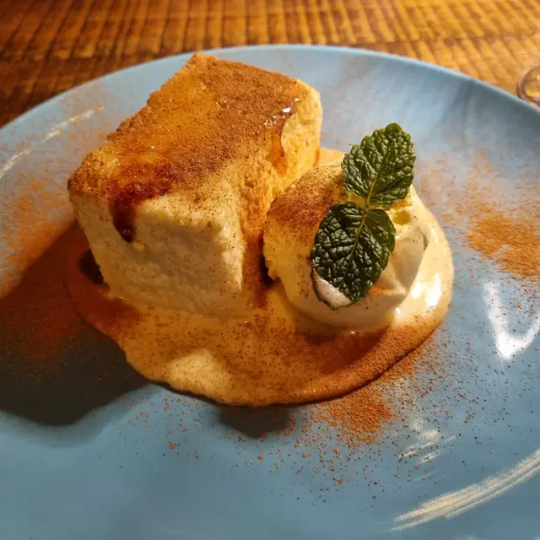
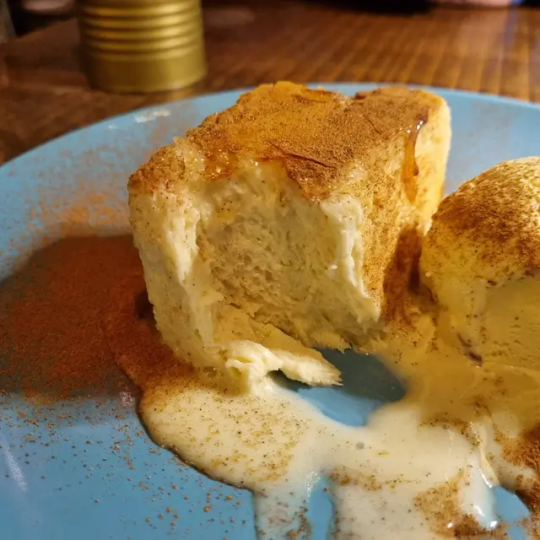

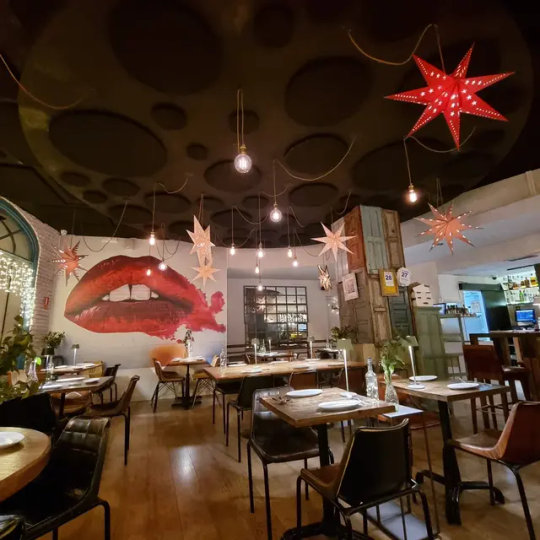
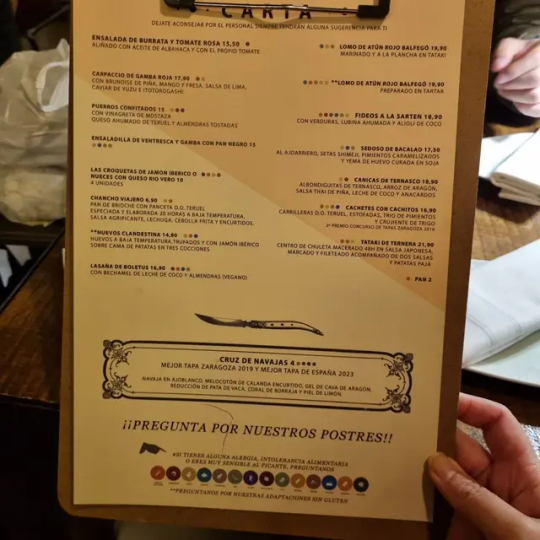
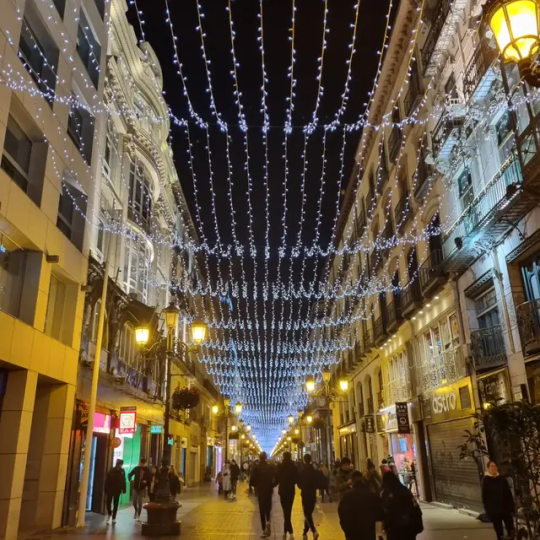
28/12/2023 - Dinner P2
🇪🇸 La Clandestina, Zaragoza
🐟 Sedoso de Bacalao (€ 17.50, $25.41)
Silky cod with garlic, mashed potatoes, shimeji mushrooms, caramelized peppers and eggs cured in soy. Fish was really tender in the potatoes but the mushrooms were wayyy too salty. Has a nice tomato dusting. A sad downfall. Not a very exciting dish. Especially since this came after the first two.
🐮🥩 Tataki de Ternera (€ 21.90, $31.80)
Beef tataki macerated in 48h japanese sauce. Comes with two sauces and straw crispy potatoes. Steak was tender enough but not phenomenal especially for the price. One of the sauces was more mustard-like and the other like a savoury steak sauce.
🍞🥚🍨 Torrija (€ 7.50, $10.90)
This was the highlight of the second part of the dinner! It was amazing. The texture of the bread is cake like and creamy in the centre without being eggy. HOW DO THEY DO IT. The middle retains the look of bread but the fork cuts through nice and easy. A definite MUST HAVE here.
Will want to be back to try the cakes and pastries. Seems like they shine for the starters and dessert. Maybe we just picked the wrong mains to have.
0 notes
Photo





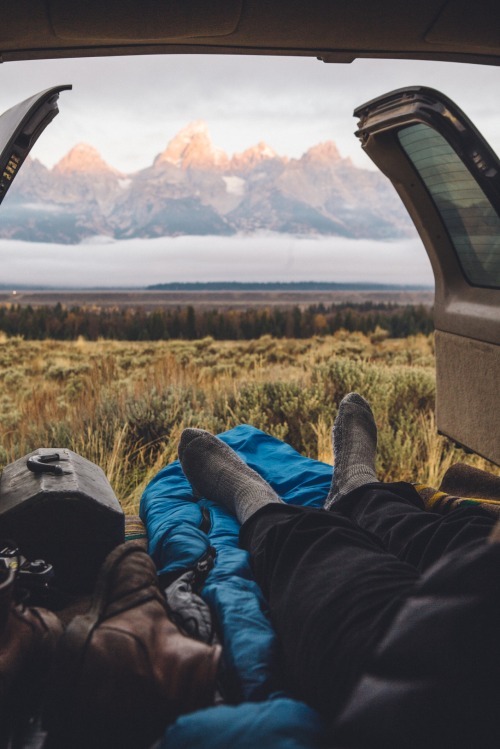
A ROAD TRIP WITH TOM HIDDLESTON WOULD INCLUDE...
Written by: Crispy Imagines.
Soundtrack: [including 4DX experience, which means ambient sounds] main theme / 1 / 2 / 3 / 4 / 5 / 6 / 7 / 8 / 9 / 10 / 11 / 12 / 13 / 14 / 15 / 16 / 17 / 18 / 19 / 20 / 21 / 22
Notes: This headcanon is set in summer (in case you’re reading this in other season). If you’d like one set in autumn, let me know by sending a message or an ask. Also, the road trip takes place around European countries like Italy, France and Spain (cause if I look further this would take forever). I swear I could’ve posted my goddamn 6hrs full playlist. No kiddin. <3
Warnings: I don’t truly believe this is a headcanon, it’s more like a story without prose haha. So, it’s a little bit long. That’s the only ‘warning’. Listen with headphones, preferably.
It’s a sunny sunday morning in London. Tom and you are leaning on your bed, holding hands and with all the time in the world to enjoy yourselves. Cause it’s summer; he’s not working, you’re not working. [1]
“Our official first day of vacations”
Both walk down the stairs right to the kitchen and prepare some breakfast; coffee, cranberries’ pancakes, eggs with tomato and a slice of toasted bread. [2]
“Now what?”, Tom repeats Finding Nemo’s dialogue provoking you to laugh.
“Summer vacations, maybe?”
“At home?”
Tom has that playful smile of him, standing up and driving you to the leaving room in excitement. Suddenly, he jumps into the couch with a bright smile and yells;
“Get your luggage ready, honey! We’re leaving to Anywhere!” [3]
Laughing, jumping and running all over the house.
In the closet, Tom takes out a couple of suitcases and leaves you there to run down to the garage.
“Where are we going?”
“Just grab what’s neccessary, not too much things, darling”, his voice screaming and therefore, echoing.
Luggage ready and a bag with secret stuff Tom didn’t wanted you to see.
Driving “to the airport!”
A sense of adventure peeking ahead.
VIP flight tickets.
Holding your hand and that playful smile again. Because this will be the time together both needed after all the hard work.
Airplane take-off. [4]
Adventure mode on.
Wine, laughs, soft kisses and a good movie during the flight. [5]
Landing on Rome. [6]
Rent a car and driving under the city lights towards a hotel.
Leaving your luggage in the suite room and out to walk.
“An evening in Roma”
Dining in a little restaurant/bistro; authentic pizza, italian pasta and a glass of wine.
Italian food = a God’s blessing.
Soft kisses before falling asleep in La Città Eterna.
"Wake up, sunshine”
Italian breakfast down a meson. [7]
“Wait. Aren’t we going to stay?”
That playful smile appearing again over his face.
Changing the car to a Jeep Renegade.
Sunglasses on.
“Ready?”
“For what?”
Tom sits in the driver place and you take the co-driver’s.
Driving towards the highway.
Buying at a convenience store (like 7-eleven) some water, a soda, chocolates, candies, and chips. Just some human energy for a 3 maybe 5-hours road trip.
Opening the M&M’s and placing some on your hand to give them to Tom in his mouth.
Singing old songs and weird songs out loud, gestures and hands dancing included. [8]
“Cause I’m Mr. Brightside!” [9]
Watching the first advertisement announcing the city Tom is driving you to.
“La Toscana! Florencia”
Tom chuckles at your reaction.
Not going right forward to Florencia, but instead visiting a town first.
Finding a beautiful inn owned by a typical italian woman, loving and kind.
Down in the little town, people don’t recognize Tom, which leads you to spend an authetic and beautiful afternoon.
Surprisingly, there’s a wedding being celebrated and both are invited by the landlady.
Being the leading dancing couple when ‘Sway’ is played. [10]
Going to sleep after 3 a.m. because of the party.
“Wake up, love”
Driving to Florencia.
Fancy italian breakfast in a fancy restaurant. [11]
Because Florence is fancy, and beauty. Art, art, art everywhere.
Visiting the daydream art museum ‘Galleria degli Uffizi’, where’s found a collection of priceless works from the Italian Renaissance.
Next stop; Venecia! (Venice)
Towards the highways.
More singing and weird talks about childhood.
Watching the sunset while driving and listening to a beautiful calm song. [12]
Decide to camp in a wonderful meadow that diverted from the highway.
That mysterious bag Tom brought has camping stuff and everything needed.
An improvised picnic at night with food bought in little stores on your way.
Wild kisses. Soft kisses. Midnight talks. [13]
More convenience stores.
Arriving to Venice.
Trying Gelato.
Gelato = a God’s gift to human race.
Enjoying the city through those boats, its magical landscapes, colors, scence and food. [14]
A short escape to Verona.
“I am truly, madly, deeply, foolishly, completely in love with you”
“O Thomas, Thomas, wherefore art thou Thomas?”
Love, Shakespeare and Italy. You never have enough.
Holding hands while walking as a love promise in the ‘City of Lovers’
More driving, but under the night sky with music surrounding you. [15]
Taking shifts to drive. Sometimes he does, sometimes you do.
Tom extending his shift if he feels you’re tired to take yours.
And it doesn’t matter, cause it’s your adventure together.
Again, more convenience stores.
Driving all the way to France without first stopping in Milan to go shopping.
Before leaving, diverting your way for a trip to Bergamo.
Camping near the mountains and waterfalls, into the woods. [main theme]
“Oh, to see without my eyes; the first time that you kissed me.”
Making love under the clear starry sky.
“Wake up, darling”
Bye, Italy. We love you.
“Sicilia! We’re coming back to Italy just to visit Sicilia, that’s for sure.”
“Of couse, darling. It’s Vito Corleone’s land.”
On the road, on the road, the road of your lives. [16]
“Turn right to take the highway to...”
“Now?”
“Yes! Now!”
*Fast & Furious kind of scene*
Sunlight burning you inside because it’s summer.
“Viva la France!” [17]
Arriving to a little town before going to the big french cities.
Showing your french skills.
“Oui”
Trying authentic french macarons.
Staying the night at a beautiful little inn.
Dancing La Valse d’Amelie slowly in your room. [18]
“Bonjour, mon amour.” (Good morning, my love)
French breakfast.
Talking with the landlady about daily life.
Back to the road.
“Are we driving to Paris?”
“Paris in the 20s?”
“Sure! Cause I’m right here in a car with F. Scott Fitzgerald himself!”
Driving through all those daydream valleys and meadows. [19]
Miraculously, you arrive to The City of Love when it’s raining.
Walking along the Seine... Paris in the rain.
Stops raining.
Visiting La Tour Eiffel.
Fancy shopping.
“Au revoir, France!”
Next stop...
“Olé, España!” [20]
Excursion to the Basilica of Montserrat from Barcelona.
Also to La Sagrada Familia.
Acting as locals in a park at Zaragoza.
“Sí, sí, gracias”
Renting a little beach house at Playa de Andrín, Asturias.
Picnic at the beach.
Tom and you playing with water like kids.
Swimming until your body wrinkles by water.
Reading and talking while his head lays on your legs.
Sunset and toast with spanish wine.
Trying paella and falling in love with its delicious mixture of flavors. [21]
Learning to dance Flamenco.
Failing plenty times until you get the rythm.
Conveniences stores (7-eleven) being the best place in the world because of the homemade candies.
“Muchas gracias por todo, España” (Thank you for everything, Spain)
Your last night driving. And it’s towards Madrid, where you’ll later pick up a flight back home.
“Hey, we got to come back!”
Driving at night in the rain. [22]
“Thank you for this, darling”
“I love you, Thomas”
Landing in London.
Of course, along your road trip, both bought several souvenirs and took photographs of every place and landscape.
Also, pictures of you two together, or eating, or sleeping, or doing whatever thing.
Back home.
“Uff”, throwing the luggage and yourselves over the couch.
If you’ve read all of this and still not eager to get out and have all those memories, then you didn’t listen to the whole 22 tracks. If you did, you’ve been a victim of my mental breakdown writing this and I don’t regret it haha
#* sobs*#Headcanon#tom hiddleston#road trip#roadtrip#road trip with tom hiddleston would include#summer with tom hiddleston#roadtrip with tom hiddleston would include#tom hiddleston x reader#imagine tom hiddleston#tom hiddleston x you#tom hiddleston headcanon#tom hiddleston imagine
202 notes
·
View notes
Text
14 Days Europe Holiday Package

14 Days Europe Holiday Package Visit Europes top destinations with our 14 Days holiday or honeymoon Package, FROM KSHS 250,500 PER PERSON SHARING, Inclusive of meals, accommodation, Return flight tickets Transfers and Excursions. BOOK NOW! PROPOSED ITINERARY Day 1 Paris Summary of The Day: A driver will be available from 7:00am to 10:00pm at the Charles de Gaulle and Paris Orly International Airports to take you to your hotel. Please meet your driver at the arrival hall. Due to the large number of passengers requiring pick-up service, the driver may ask you to wait 10-15 minutes for other passengers arriving just before or after your flight. Please be patient! Hotel: Residhome Paris Guyancourt / Balladins Hotel Villejuif or similar Day 2 Paris - Versailles - Paris Summary of The Day: We'll begin our Paris adventure with a drive along the famous Champs Elysees to the Place de la Concorde, which played a key role in one of darkest chapters of the French Revolution. You'll also get to see the iconic Arc de Triomphe. Next we'll head to L'Hotel National des Invalides, which houses Napoleon's tomb and a number of other monuments relating the military history of France. Next we'll travel by coach through the Parisian suburbs to the splendid Palace of Versailles, residence of the royal family until the start of the revolution in 1789. We'll return to Paris in the evening. After dinner you may want to avail yourself of the optional cruise along the river Seine. Hotel: Residhome Paris Guyancourt / Balladins Hotel Villejuif or similar Day 3 Paris Summary of The Day: The second day of our Paris experience begins with a visit to the Louvre, the grande dame of art museums. Here you will set your eyes upon some of the highest-valued masterpieces of the Western world, including the Venus de Milo, Winged Victory of Samothrace, and the Mona Lisa. After lunch we'll head to Boulevard Haussmann, a shopper's paradise in the heart of Paris, where you will be free to shop till you drop. Accommodations for the evening will either be in Paris or a neighboring city. Before you leave this captivating city don't miss the world-famous cabaret shows at Lido and Moulin Rouge (optional). Hotel: Residhome Paris Guyancourt / Balladins Hotel Villejuif or similar Day 4 Paris - Lucerne Summary of The Day: We will depart for Switzerland in the morning, first passing through Basel - situated at the intersection of France, Germany and Switzerland - before arriving in Lucerne, where we will stay the night. Hotel: NH Lucerne / Hotel Arcade or similar Day 5 Lucerne - Milan - Venice Summary of The Day: After breakfast, we'll head south to the design and couture-conscious city of Milan. On our tour of the city you will see Galleria Vittorio Emanuele II, the oldest shopping arcade in the world; the legendary opera house La Scala; the storied Sforza Castle; and the ostentatious Gothic of Milan Cathedral. Accommodations for the evening will be in Venice or a neighboring city. Hotel: Hotel Plaza Mestre / Sheraton Padova Hotel or similar Day 6 Venice - Rome Summary of The Day: After breakfast, we'll take you through this fascinating city of ornate palaces, lyrical waterways, captivating churches and impressive architecture. In San Marco Square you'll see the Basilica di San Marco, one of the best examples of Byzantine architecture, and the Bridge of Sighs connecting the old prison to the interrogation rooms in Doge's Palace. Afterwards, you'll get a chance to see some traditional Venetian craftwork at a demonstration by Murano glassblowers. An optional gondola ride on the Grand Canal will put the finishing touch on a glorious day in Venice. Accommodations in the evening will either be in Rome or a neighboring city. Hotel: Idea Hotel Roma Z3 / Domina hotel conference capannelle-roma or similar Day 7 Rome - Vatican City - Arezzo Summary of The Day: After breakfast we'll head directly to St. Peter's Basilica in the Vatican, originally built by Constantine the Great in 324 AD, then reconstructed between 1506 and 1615 under the direction of several famous architects including Bramante, Raphael and Michelangelo. You may also join the optional Sistine Chapel tour to view Michelangelo's famous frescoes. Next you'll see the famous Trevi Fountain, the lavish Baroque showpiece where people flock to throw coins into the water - an action which is said to ensure that you’ll return to the city again one day. After lunch, take a step even further back in time as you visit Italy’s unrivaled Roman relics. An optional guided tour of the Colosseum, built in AD 72, comes highly recommended. History comes to life as you imagine yourself witnessing gladiatorial combat inside the spectacular amphitheatre. You may also choose to walk at your leisure around the outside to admire the facade of this ancient wonder. After the Colosseum, get up close to the nearby Arch of Constantine, which dates back to the fourth century AD, then spend some further free time enjoying Rome, sampling the rich and creamy delights of gelato. After some free time you can either visit Basilique Santa Maria degli Angeli e dei Martiri (Basilica of St. Mary of the Angels and the Martyrs) near Piazza della Repubblica, or head directly to the nearby Mitsukoshi Department store for some serious shopping. Hotel: Etrusco Arezzo Hotel / Arezzo Park Hotel or similar Day 8 Florence - Pisa - Genoa Summary of The Day: On this day you will be introduced to the sights and sounds of Florence, the birthplace of the Italian Renaissance. We'll head up to the Piazzale Michelangelo for a panoramic view of Florence, then to a local workshop to see how Florence's fine leather goods are made. Afterwards, we'll set out on foot to the Ponte Vecchio over the Arno River, the Duomo, Giotto's Bell Tower and the Uffizi, which houses one of the finest art collections in the world. At Pisa, our last stop of the day, you will be free to wander; be sure to have your camera ready when you enter the Square of Miracles and the iconic Leaning Tower of Pisa, Pisa Cathedral and Baptistery come into full view. Hotel: Loano 2 Village / Miramare Continental or similar Day 9 Genoa - Monaco - Nice - Grasse - Cannes - Avignon Summary of The Day: A breathtaking drive along one of the most sublime stretches of Mediterranean coastline awaits as we say goodbye to Italy and hello to Monaco. Our walking tour will take us first to the Prince's Palace of Monaco, then on to the Courthouse, the Oceanographic Museum and Saint Nicholas Cathedral, the resting place of Grace Kelly. We'll then travel to the Fragonard Perfume Factory to learn about the perfume-making process. At the end of the guided tour you will be able to purchase one of the fragrances for yourself. Next we'll visit Nice for a sampling of the scrumptious local cuisine. We'll stop over in Cannes to see the Palais des Festivals et des Congres, host of the city's annual international film festival, and then make our way to Avignon Nord to check in to our hotel. Hotel: Novotel Avignon Sud / Express by Holiday Inn Avignon or similar Day 10 Avignon - Paris Summary of The Day: Take a well-earned rest today as you sit back and enjoy the rustic charm of the French countryside on our journey north to Paris, the Green Line terminus. Hotel: Residhome Paris Guyancourt / Balladins Hotel Villejuif or similar Day 11 Paris - Madrid Airport drop-off for further journey to Spain. Welcome to Madrid! Upon arrival at the Adolfo Suárez Madrid–Barajas Airport, a driver be waiting to transfer you to your hotel. Our guide will be ready to welcome you and will provide the necessary information. In the evening we'll head to Plaza de Espana and Gran Via, a vibrant district where you can dine at your preferred restaurant, which multiple cuisines to choose from. Visiting Attractions Madrid Gran Via Plaza de Espana (Madrid) Temple of Debod Hotel: Hotel Praga / Hotel Melia Avenida America / Weare Chamartin or similar Day 12 Madrid - Barcelona Madrid - Zaragoza - Montserrat - Barcelona Hotel: Front Air Congress / Hotel HLG CityPark Sant Just / Hotel Fira Congress Barcelona / Hotel Novotel Barcelona Sant Joan Despi or similar We'll depart early in the morning from Madrid and head towards the stunning region of Aragon, stopping in the city of Zaragoza. Here we'll visit the magnificent Basilica del Pilar and then enjoy some free time in the city center. Later, we'll make our way to Catalunya and admire impressive rocky landscapes, making a special side trip to Montserrat Monastery (rack railway fare included). Then we'll arrive at today's destination, Barcelona! We'll head to the Plaza de Colon and Maremagnum, a vibrant area right next to the sea. This is where the most innovative spirit of the city blends with its deep historic character. Visiting Attractions Barcelona Zaragoza Basilica Cathedral of Our Lady of the Pillar Montserrat Santa Maria de Montserrat Day 13 Barcelona Hotel: Front Air Congress / Hotel HLG CityPark Sant Just / Hotel Fira Congress Barcelona / Hotel Novotel Barcelona Sant Joan Despi or similar Today we'll get to know Barcelona, an impressive city right on the Mediterranean. Our visit includes an informative city tour with a local expert and visit the city’s historic central area with its Gothic neighborhood dating back to the Middle Ages. Then we will visit the area where the Olympic Games took place, Barcelona Stadium as well as La Sagrada Familia, the magnificent basilica designed by architect Gaudi (admission not included). Afterwards, we'll head to Poble Espanyol (Spanish Village), an open-air architectural museum in one of the most emblematic areas of Barcelona. Be delighted by the best Spanish craftsmanship and discover the architectural styles, traditions and folklore of the different communities in Spain. Then you'll have free time to explore the city on your own. In the evening we'll head to Las Ramblas and Plaza Catalunya area, where you can select from a great variety of restaurants for dinner. Visiting Attractions Barcelona Spanish Village (Poble Espanyol) Barcelona Olympic Park Barcelona Stadium Barcelona Gothic Quarter La Rambla Day 13 Departure Breakfast in the hotel,transfer to the airport for a flight back home. *******************END OF SERVICE************ Hotels used: Starting from; Package Price/Person By Occupancy Double KES. 250,500 Single KES. 380,800 Package includes: Return Airfare from Nairobi Complimentary airport pick-up and drop-off 13-night hotel accommodations Breakfast (coffee or tea, juice and bread) Ground transportation in air-conditioned motorcoach Professional tour guide Package excludes: Mandatory Service Fee (min. EUR 5.00/day per person, payable to the guide on Day 1) City Taxes All personal expenses and additional hotel services Lunch and dinner Optional tours (prices and availability subject to change): Paris Night Tour: EUR 35.00/Person French Dinner : EUR 65.00/Person River Seine Cruise: EUR 13.50/Person - Lido Show : EUR 140.00/Person - Moulin Rouge Show: EUR 140.00/Person (Age restriction: 18 and up) - Venice Gondola Ride: EUR 25.00/Person - Sistine Chapel Tour: EUR 45.00/Person - Colosseum Guided Tour: EUR 35.00/Person(Skip-the-Line) Tour guides and drivers rely upon the service fees charged on the tour to supplement their income. The wages of tour guides and drivers are determined factoring in that they will receive service fees to augment their earnings. Please pay at least the recommended service fee because the tour guides and drivers Terms and conditions Flight fares change from time to time, please recofirm at the time of booking Rates are subject to change with availability Read the full article
0 notes
Photo
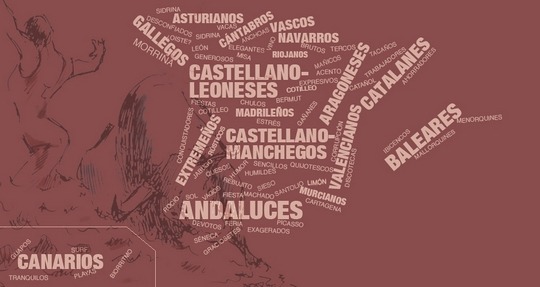
@hetaliafandomhub EMBASSY : SPAIN
WRITING REFERENCE: REGIONS & CHARACTER TRAITS
Spain Works a little bit like a federation… except not really. The different Spanish regions are called “Autonomous Communities” and are semi-self-governing territories that were established following cultural and historical reasons, almost 40 years ago.
This has brought some problems, but also a lot of hilarity, because the rivalry between some of the regions created a ton of funny jokes and stereotypes.
There are 17 Autonomous communities and 2 autonomous cities.
So there’s no such thing as one and only, defined, version of Spain and Spanish people, rather Spain is a sum of all its differences. Like a real person, our country is polyfacetic, complex, and often contradictory in its behavior, preferences and personality. But at the core, there’s just something that we all have in common and that sets us apart.
I prepared a little, humorous piece on each region, highlighting its traits and most common stereotypes. Of course, this is oriented towards writers that want to make their character representation richer and more extensive.
You can use any of the following for Antonio and combine them at your like:
THE AUTONOMOUS COMMUNITIES
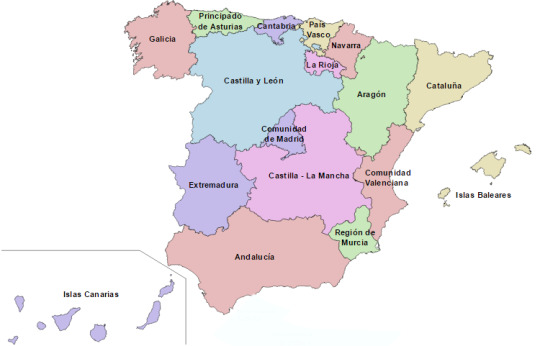
Aragón: Legend has it, that not long ago the people from the aragonese Pyrenees still communicated with each other by yelling over the mountains. Whether that’s true or not, Aragón is considered the land of loud and headstrong people. And when I say headstrong I mean so stubborn that they will rather change the laws of physics than admit that they were wrong about something.
Their capital is Zaragoza and the cold is manufactured in its train&bus station. Seriously, its manufactured there and then exported to the rest of the world, I shit you not!
C. Valenciana: If orange trees disappeared from the face of the earth Valencia would cease to exist.
It’s the birth land of the paella and they won’t let you go until you’ve understood that. They are known for their corrupt politicians and have more metrosexuals for square meter than a gay gym. Speak catalan but call it “valenciano” and demand it to be treated like a completely different language. Collectively healthy and well-groomed. Valencian people are carefree, a little bit arrogant, and enjoy living the good life.
They also adore gunpowder; whether it’s a wedding or a funeral – there’s gonna be fireworks!
Asturias: “Spain is Asturias and the rest is reconquered land” and no Astur will ever let you forget that. They consider themselves the reason Spain exists in the first place and love reminding it to the rest of the country, whether it’s in the parliament or heavy metal songs. They really love their land, carry an Asturian flag everywhere they go, take pride in their history, landscapes, nature and… milk.
Anyway, their superiority complex is legendary and the worst part is that you can’t even pick on them for that because it’s all mostly true.
La Rioja: If you’ve got a wine mom, have ever been in the alcohol section of any supermarket, or studied the wine selection in a restaurant menu out of boredom, you probably know the word Rioja. It’s one of the most famous Designations of Origin in the world, which often leads to the assumption that Riojanos are drunk 90% of the time. Wrong. They are only drunk 70% of the time. They’ve also got a festival that is just like one giant water battle… but with wine instead.
Okay, jokes apart. Rioja has a lot more than just wine; its people will take you in with open arms no matter where you are from and make sure you never want to leave.
Andalucía: What the rest of the world thinks is Spain. Every stereotype you can think of? Surprise! Turns out it’s only applicable to Andalucía. Flamenco, frilly dresses and women called Carmen come from there. Sadly, they are often treated like a joke by the rest of the country, but to give them credit: take it really well.
Although in the rest of Spain we are convinced that the religious devotion is actually an excuse for huge parties and let’s be fair – you’d also siesta if the temperature outside got to 50ºC in summer afternoons. Andalusians are also everywhere; wherever you go you’ll find hordes of them and recognize them by their funny accent.
Galicia: Other countries have china-town. We have one giant Ireland-town and it takes up this entire region. Galicia is extremely beautiful, has a lot of forests and a very unique culture, not to mention a very sticky accent and their own language; which is so closely related to Portuguese it’s difficult to tell them apart.
Now, the Galicians are the human form of “to be or not to be”; or alternatively the object of Katy Perry’s “hot’n’cold” song. You won’t find more indecisive bunch on the face of the earth. They’ve also got collective “morriña” which nobody is really sure what it means but it’s sort of a good-melancholic feeling.
Cantabria: In Cantabria, one in every four habitants is a cow. Also, the last time something metal happened there, it was in the times of the Roman invasion.
They have the best anchovies and will not tolerate any offense against them. Apart from that, they are fine people that may be a little bit cold but talk in sing-song and work very hard and a lot. A little bit hard to crack maybe, or that might just have been my former housemate.
C. de Madrid: So… turns out there’s an entire Autonomous Community surrounding the capital. Although, to be fair, the city takes up most of it.
The Madrileños are always stressed out, always! They are always rushing everywhere like devil’s got their pants on fire and still get there too late. In an eternal competition with Barcelona about literally everything. They are also really prideful, but I’ve said that just about any region till now. Also, it’s the capital, they are supposed to believe themselves the shit xDDD
País Vasco/Euskadi: The special snowflake of Spain and the entire Europe now that we are at it. Actually rumored to be aliens. Their language doesn’t come from indo-european, their genetic code is different, there’s a hereditary disease similar to chronic insomnia that only affects Basques… What even are these creatures?
It doesn’t matter; we still love their pinchos, and making jokes about their brute strength. Because believe me when I tell you: there’re no humans on earth as BRUTE as the Basques. Yes, I also thought that was an exaggeration, until I started sharing an apartment with one.
Navarra: Are they actually Basques? Are Basques actually Navarros? We might never know. The truth is that the Kingdom of Navarra was one of the cool territories during medieval Iberia and now they are famous for their Asparagus.
Okay that was mean. Navarra is actually a beautiful place (with fiscal privileges) full of history and people that might never win a subtlety and delicacy contest, but party like no-one else on the face of the earth!
Murcia: When Spanish kids are little and learning the Autonomous Communities they always forget one while counting on their fingers. That one is always Murcia. Nobody knows why it’s even a region on its own. Maybe it’s because of the language? Although make no mistake, they don’t have another language, they speak Castilian… probably, but nobody understands them anyway.
I know I’m being quite rough, but my former step-dad, the man that raised me, was originally from Murcia. They are admirably good at making jokes on their own expense. Let’s give them credit for that, at least.
Islas Baleares: *currently under the occupation of German tourists*
There’s not much to say about the Balearic Islands. As any overly-touristic place, they’ve lost a bit their essence, but some charm still remains. They are also paradisaically beautiful. I remember Formentera looking like a real-life movie poster with see-through water and marine animals swimming between your feet.
But if you really want to learn about Spain, our culture and people – don’t choose Mallorca for your vacation. I’m sure at this point the locals will thank you for that too.
Castilla-León: The buffer between the green north and the barren south. Those scholars that are trying to discredit the “Duero Desert” theory obviously never had to drive through the area itself for hours. It is still pretty much a desert full of wheat and olive trees. And the occasional city from time to time.
Now, that region is old Spain, Valladolid used to be the capital before it got shifted to Madrid, as León was before that. If you want a lungful of history – just visit any town in that region, it’s bursting with it. Also they are supposed to have the most perfect, correct Spanish and its people love visitors.
Castilla-La Mancha: Even more wheat fields… wheat fields as far as the eye can see. Finally, after days of wheat fields you see a town on the top of a hill, it’s surrounded by a medieval wall and in its heart a castle stands tall and mighty. You climb the hill and enter the city. Everyone is carrying a sword.
You stand there thinking whether you are hallucinating from the heat or just time travelled. Until a fuckboy with a Vespa almost runs you over. Turns out that’s only their aesthetic™ and you haven’t left civilization at all. Enjoy your stay, it’s f*cking magical. (srsly tho: I really want to visit Toledo again)
Extremadura: I don’t know what’s in the water in Extremadura but its natives are always ready for battle. Seriously, almost all the famous (and universally despised) Spanish conquerors in history were from Extremadura. They are direct, opinionated and blame Portugal’s entire existence for not having a beach.
I mean it, never cross an extremeño, but having one as a friend is probably the best investment you can make. They also work the earth a lot, remain unusually religious and have a weird obsession with making dick jokes about their own region’s name. Oh, and they also make ham!!
Islas Canarias: Their days last 23 hours, shipping companies ignore them, the magazines are more expensive, and you never know how to find them on a map. No, I mean they are pretty visible on a map of Spain, there down in a small square shape reserved only for them. But try to find them on a world map, I dare you…
Anyway, they officially have the best climate on earth, receive loads of tourism, and grow the famous “plátanos” – Spanish-branded bananas, and I’m pretty sure also that weird bunch-y shape on the top of Toño’s bangs – along with many other things. The highest mountain in Spain is there and it’s a volcano.
Cataluña: Saving the best for last. And if that sentence is not the epitome of Catalan character then I don’t know what is. Seriously, my dearest home region needs to chill and a lesson in humility, but we are not that bad. The bit about us being hard workers is relatively true, as well as the stingy bit. We’ve got 99 problems but a lack of imagination is not one of them, for better or worse. Hipsters be here.
And finally; we like taking risks, as evidenced by our “castellers”: human towers as high as possible and on the top, 15m from the ground – a four year old kid with a bike helmet.
Take that one, Spiderman!
THE AUTONOMOUS CITIES
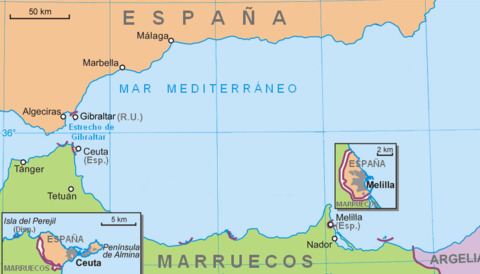
Ceuta and Melilla: Established like at VII B.C. by the Phoenicians, they passed through a lot of hands.
Melilla became Spanish in the latest stage of La Reconquista, in 1497. Since it used to be a Visigoth territory too, it was symbolically important for the Catholic Monarchs to take particularly that one city, and so they did.
But the custody of Ceuta was won in the divorce from Portugal. When in 1640 Portugal decided that the Iberian Union sucked, Ceuta, a formerly Portuguese territory, demanded to stay with Spain. Aww, such a cutie!
So this is it! I hope you enjoyed this wild ride. Aren’t we just a lovely bunch? xDD Anyway, as I already said – you can combine and extrapolate from any of these to form your preferred version of Spain. Just don’t forget that they are still only stereotypes! ;)
Please reblog to spread the word (and so I don’t feel sad because this was quite hard to make...)
Header and references: (x)(x)(x)(x)
And now a private word to the Spanish people around here:
¡Que nadie me venga ahora quejándose, que esto lo he hecho pa hacer guasa! Y si no os gusta, pues no haber dejado la imágen del país en manos de una catalana, cony xDDD
Será posible, que algunos países tienen como de 3 a 5 representantes y a mí me habéis dejado sola, panda de vagos. Venga, que presentarse a portavoz no cuesta nada… (porfii~ me siento solita 😢)
#aph ambassador#aph spain#btw: the mapping is from wiki#hetalia fanfiction#hetaliafandomhub#me he dejado alguna? creo que no#open to use#reference#si he puesto a murcia esque están todas xDD#spain#writing reference#embassy board
82 notes
·
View notes
Text
Captain’s Log: My 2nd Barcelona Birthday. A Barcelona appreciation post.
Today (as of writing), marks my 2nd year in Barcelona.
2 years ago, I packed my entire life (ok, just a bunch of clothes really) into 2 giant bags , boarded a 17hour KLM flight, and went off on a grand adventure.

And while I seem to be complaining about a lot of things Barcelona related lately -
the extra taxes I had to pay for just quite recently
the metro strike that happens on a weekly basis now,
but at least not on the same days as the taxi strike
the lack of access to some things I've pretty much taken for granted all my life: Apple Cider Vinegar, Malunggay, Corned Beef, Jollibee, 24/7 convenience stores
the lack of soul who can understand what I mean when I say "charot"
The list of things to love about Barcelona is far longer. So here's my top 10:
1. I can actually commute. Sure there's a metro strike nearly every Monday on the worst possible hours ever, but on most days - going from point A to point B is, at most, a 30m subway ride, with the nearest metro stop just a 3 minute walk from my place. And if the metro is not working, the buses are also as safe and reliable. Meaning, they're not trying to break your neck trying to drive 100mph all the time so they can reach their quota number of trips.
Just hang on to your bags, because while the transportation itself is great, the other passengers are not. I've been pick-pocketed once on a 6am drunken ride home from Villa Olimpica to Joanic. Never again (drunk on a train, I mean).

2. I can find and get a doctor's appointment online! Victory for the introvert in me. Back home, all of my doctor's appointments are c/o my mother. Not that I'm completely useless - it's just that my parents' doctors eventually became my doctors too.
I remember 3 years ago when I was trying to hide a kidney stone problem from my mom, I went to the hospital by myself, armed with just my medical insurance. I had to queue up because I didn't know any kidney doctor accredited by my insurance that I can call directly for an appointment. I waited for 2 hours just to get a name. I had to wait another 3 hours after to see the doctor.
Fast forward to a few weeks back and I was suffering from an ear problem! I needed an English-speaking doctor, of course. Expat colleague told me about the hospital 5-minutes away from the office and that I'll definitely find what I'm looking for there. So I googled the hospital. Et voila! Found out that I just can book things online by just saying what kind of doctor I needed to see and they'll pull up the available dates. Picked a date, and then I just showed up on the day with my insurance cards and I just had to wait 10m to be called.
3. The beach is just 7 metro stops away from my house. Ok so I'm not really the biggest beach person (more about that in another post). The number of times I've been to the beach in the last 2 years is already 10x more than the number of times I've been to the beach in the last 10 years when I still lived back home. I think the proximity plays a huge role.
Going to the beach with a blanket and a book is my favourite cliché though, and I love that Barcelona has given me the opportunity to actually live it - minus the bikini and the abs that seem to be the requirement.
4. Doing 10k steps a day is easy. Sidewalks exist. I don't have to worry about being side-swept by a car, a bus, or a motorbike if I want to walk home from work (which I actually do!). I can still get sideswept by asshole bikers but that's a lot less painful than a 1,500 kilogram box of steel, let me tell you.
I remember my first month in Barcelona, I walked to everywhere! Not because I wanted to walk but because walking seemed like a better alternative than facing my fear of getting eaten by the metro system and having to ask somebody for help.
And since I don't dare step inside a gym (except for Spinning classes every once in awhile), walking is a good alternative to running on a treadmill.
5. Museums, museums, museums! Really. Free museum Sundays are the best. MACBA, CCBA, MNAC, Picasso museum, and many more. And all I need is the will-power to drag myself out of bed and go there. They're all walkable or maybe 20m away via metro. There's always an event every 2 weeks. And to be honest, there's always a new museum that I haven't checked out every 2 weeks as well.
If ever I am bored in this city, it's my own fault.
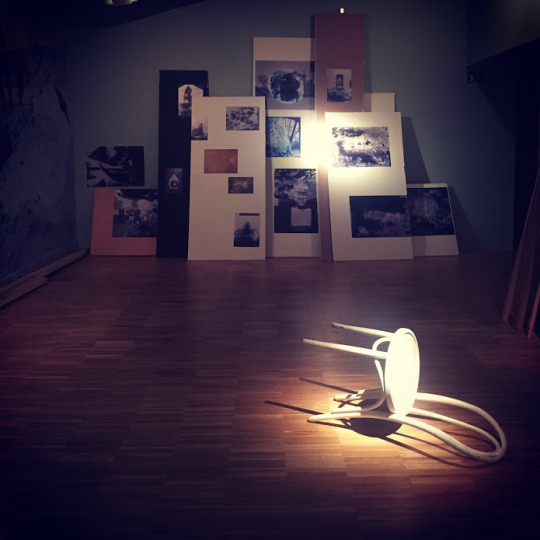
6. The plazas. Bar food ain't great. But eating bar food with a side of beer, in a terrace in the middle of Gracia is more than great. People watching or gossiping, while you're chugging down beer, under the stars, is one of the best ways to kill time on a Friday evening after a long week at the salt mines -- and not be in the middle of the mall (ehem Greenbelt), or practically on the street in danger of getting run over by cars, taxis, and jeeps (ehem Makati). While they charge a bit more for the terrace tables, bar chow and beer still tend to be on the cheap side.
And if you're lucky, sometimes in Plaza del Sol, some (apparently) well known band will show up, set up with their acoustic guitars and cajons, and just start playing for shits and giggles.
7. Travel is easy (and cheap). Last week I took a friend to Girona (where they shot scenes from GOT), just for a 30€, 30m train ride. There's a fast train to Madrid, Valencia, Zaragoza, and to other cities in Spain. Lisbon is a 2h flight away, and so is Florence and Berlin. And round trip flights can cost you as low as 40€. If my wallet is a bottomless pit of Euros, I would be traveling every 2 weeks. Except that it's not and I only have 26 days of holidays to use.
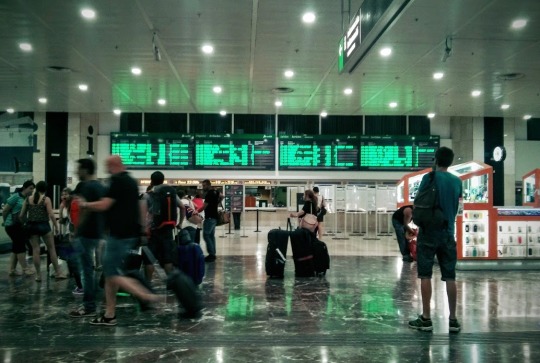
8. Fiesta de Gracia. Every year, in August, my neighborhood goes insane decorating the streets according to a particular theme, trying to outdo each other in making the best papier maché art. There's a street party in every corner. And beer is as low as a euro. There are fireworks (firecrackers, really). There are giants. And there are concerts in the plazas. And for a few days, the locals and the tourists get drunk side by side and get along.
It's a magnificent site really. Although it can be a pain in the ass if you live here (luckily for me, while I live in the neighborhood, I sit right on the border so the party never reaches me) because the noise won't let you sleep, and the smell of pee will haunt you forever.
9. I get to live my dream of becoming a tour guide. I take pleasure in giving my friends both the touristy tour, and the "insider" tour when they're here. Of course, the Gaudi things are a must. But where to eat and drink is where I shine.
I like taking my friends to drink at the plazas, and steering them away from the overpriced scam of the restaurants in Gothic. I like showing them the streets that held the scenes of The Shadow of the Wind (at least to the ones who read it), and then stuff their faces with patatas bravas and mussels at tiny restaurants tucked in the smaller, more residential streets, of Gracia.
And when they flood their Instagram feed with pictures of their trip, captioned with "food-gasm" or "#besttripever", the sore feet and the extra pounds gained after were all worth it.
10. The opportunity to get to know myself better. What's a KAX blog post if there's no cheesy, moral of the story to it? While the last 2 years have shown me my boundaries, it has also shown me that I can be resourceful and persistent enough to not let them stop me from pushing forward. It has shown me that I can be independent and that I can take care of myself (struggling a bit here, but I'm learning). It has shown me that while my anxieties seem paralyzing sometimes, I also can drag myself out of bed kicking and screaming because I've never really acquired the taste for defeat.
It may sound terrible -- but while I do miss my friends, and my family, and the many comforts of home: I'm so glad to be here in Barcelona and be given the chance to slowly (really slowly) be the person I would like myself to be.
Bonus:
Getting called guapa, all the time! And not in a sleazy "Hola, guapa, give me a smile" kind of way either. The cleaning ladies in our office always says "hasta mañana, guapa!" when I say goodbye. Or the store owners after I've paid for my purchases tell me "Gracias, guapa!". Even the old lady in my building whenever I run into her in the lift always says "Buenos dias, guapa!"
Never mind that they probably say that to everybody, so I'm not special. I still take it as a validation and I say goodbye with a smile on my face, and a renewed confidence that puts an extra spring in my step. Priceless.

So yep, 2 years! Wow.Last year I wrote about how life has been so far, one year in. No major changes have occurred since then. Just tiny ones. Like:
My Spanish is still ridiculous but functional. I've moved up a half a size when it comes to my pants. I still haven't learned to walk in heels - and to be frank, I've given up. I've gotten way better in cooking. And all my clothes are still intact despite having to do my laundry and ironing by myself. Friends, I have. And they are a fantastic group of people. My lights still need changing, and so does my shower head. My savings is a joke. But I think this is the version of Kax I like the best :)
2 notes
·
View notes
Text
Friday, 13 January 2017: the feast of the Baptism of the Lord. The Christmas season reaches its conclusion today, with the commemoration of the Baptism of our Lord in the Jordan River. As Christmas is the feast of the Word’s incarnation, so the feasts of Christmas season (Holy Family, Holy Name, Epiphany, and Baptism) are extended meditations on the progressive revelation to the world of God’s Incarnation. “The Word became flesh and dwelt among us, full of grace and truth; we have beheld his glory, glory as of the only Son from the Father.” (John 1:14)
It seems then that I should probably write a bit about my Christmas trip (if I ever intend to do it!). Mom probably wants to see some pictures, so here goes.
I spent the Christmas holiday with a group of three other seminarians in southern France and northern Spain. We all thought, “You know what sounds like great fun in the coldest and wettest part of the year? The Pyrenees!”

(”I want to see MOUNTAINS, Gandalf!”)
So we all traipsed to a monastery named Le Barroux for the last few days leading up to Christmas. Le Barroux is a traditional Benedictine monastery a couple hours from Marseille, and they mercifully had a somewhat heated church. (I say “somewhat”: I was still wearing wool coat and gloves for the morning offices, but the water in the fonts was liquid, which is an improvement on the frozen fonts of Fontgombault.) But one of the unofficial requirements for “NAC Christmas” is to go somewhere they have real beer and real butter (which, for most of us, means France, England, or Germany), and that was certainly fulfilled by a stay with French Benedictines! I love Rome, but it sure is good to get out of Italy sometimes!
Have you been to a real monastery? It’s incredible. What a beautiful, prayerful place. The monastery is out in the French countryside, surrounded by olive groves, vineyards, orchards, and in the distance, low mountains. The monks rise at 3:20 each day to start their daily prayers, all chanted in the fairly plain stone church. I was on “retreat mode” and mostly slept through the nighttime offices: I really admire those men for their endurance. They pray seven different “hours” (the name for the praying of the psalms) during the day, plus Mass. Fifty men, all in black, moving with simple reverence and practiced ease. We don’t talk with them, but the atmosphere is certainly welcoming. Even the meals are taken in silence, which can be a bit jarring at first (but for the Roman escapee, this is wonderfully soothing).
The countryside, too! I get to a point every couple months when I decide that it’s time to go up a mountain again, and also see the stars to remember what the night sky looks like. Le Barroux provides!
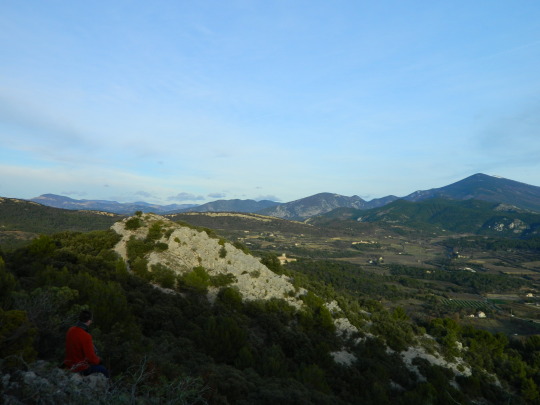
(The monastery is in the center, just to the right of the foreground mountain.)
I spent several cold nights looking up from the darkened cloister at a night sky with no moon. I saw faint traces of the Milky Way for the first time.
And then Christmas arrived! The most tiring day of the year for the monks! The prayers begin with Matins at 8:45 pm on Christmas Eve, which leads straight into midnight Mass. We all have some drinks and cookies afterward, and then get to bed by about 2:30. Then up again at 6 am for Lauds and Mass at dawn! And a third Solemn Mass once the sun actually comes up! And the priest-monks have their own Masses to say, after they attend in choir! It’s certainly a strenuous exercise, but very beautiful.
My French survived the disuse of a semester, too! The Abbot speaks very clearly, and I could understand a good deal of his homily. I’m really pleased with that. But more French adventures later.
After Christmas, we rented a car and traveled each day to a new city: Barcelona, Zaragosa, Pamplona, Loyola, San Sebastian, Lourdes, Toulouse, Carcassonne, and Nimes. Plenty of adventures along the way, but I’ll just tell a few of them.
First off, we had a hilarious cab driver from the monastery to the train station to begin our trip. He had an almost-incomprehensible Provençal accent, very deep and from the back of the throat. You think French is a throaty language?! Good luck! Anyway, we were attempting to fit our bags into the trunk of his cab, and they just didn’t quite fit. But he shoved the last one in, and with a booming “BON!” smashed the hatchback closed. Which action was accompanied by a worrying plastic crunch. Also, the trunk didn’t close. A bit of rearranging, and it did close, but we had a catchword for the rest of our trip. Every time we resumed our travels, or were ready to leave a restaurant, or had found our lodging for the night: BON!
We stayed the first couple days at another convent near Barcelona, at a famous medieval Marian shrine called Montserrat. Here, Catalan became the twelfth language I have heard Mass in (English, Latin, Polish, Italian, French, Spanish, Icelandic, Portuguese, Croatian, German, Lithuanian). It is also probably the least beautiful. Ach, Catalan! We had plenty of fun doing very bad impersonations of Catalan. But the people are very kind, and Barcelona is beautiful. I finally got to see the Sagrada Familia in full color, during the day.

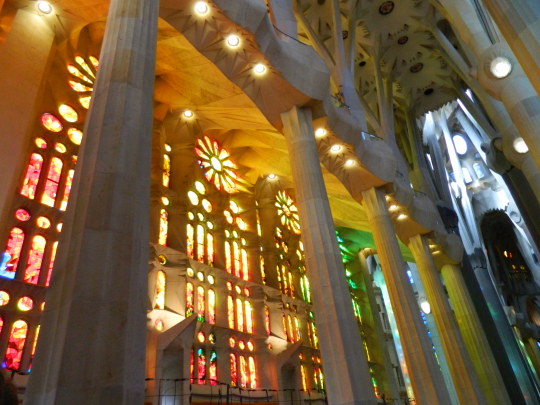
We began our dual pilgrimage at Montserrat, where we sang a medieval pilgrim song called Stella Splendens and saw the Mary altar where Saint Ignatius left his sword as a token of his conversion and dedication to the Gospel.

(Saint Ignatius the Pilgrim, bearing his sword as an offering, Montserrat)
As we passed on to Zaragoza and the magnificent Shrine of Our Lady of Pilar, we stopped also at Manresa and prayed in the cave where Ignatius received the Spiritual Exercises during his long meditation. From there, we moved along to Basque country! Basque is something of a foil to Catalan: it looks ugly in print, but it is very beautiful spoken. I have no idea what they’re saying, but it’s quite pleasant to listen to. We stayed at a converted farmhouse in the hills above Loyola, and spent the day at the castle-turned-shrine where Ignatius grew up. The museum of Ignatius and the early Jesuits is the best “saint museum” I have ever visited, and the most moving part of our trip, for me, was seeing the place “where Ignatius of Loyola gave himself to God.”
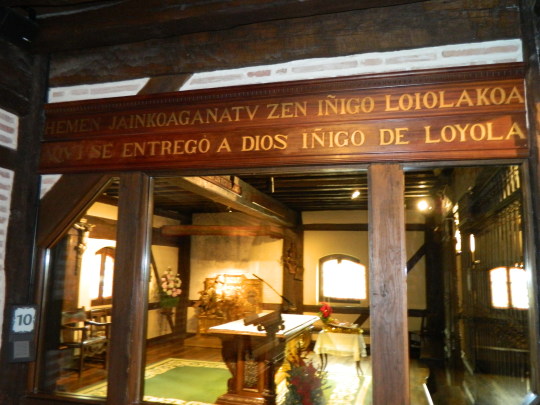

(”Here Ignatius of Loyola gave himself to God.”)
Also: mountains!

After a brief jaunt through San Sebastian, we ended up at Lourdes for New Years’ Eve and the feast of Mary, Mother of God. I finally got to climb my mountain! And we prayed in the New Year from the Grotto where the Immaculate Conception appeared. I honestly don’t know how bishop offered the Mass. I was in underarmor under my pants under my cassock under my wool coat, and I was still frozen. I don’t know how his fingers had dexterity enough to handle the host. God bless him.

After that, we went on to visit Saint Thomas Aquinas in Toulouse (church is closed Monday! Bah!) and then continued on to a marvelously-preserved medieval town called Carcassonne. (My brother Keith would have had a blast tramping around the battlements. I would have been with him.) But the best adventure was staying with a house of Cistercian nuns. We had searched “Monastery near Carcassonne”, and theirs was the only website that worked, so we ended up driving along a one-lane road to a village, then along a dirt road into the countryside, and finally up a forest logging road, in order to reach a little convent in the middle of the woods. I thought the stars at Le Barroux were spectacular! There’s a little convent of five Cistercian sisters, making jams and bottling essential oils, and praying for France and for the world. What devotion! And they have a new vocation coming at Easter! God bless them!

Finally, we made our way to Nimes, which was an ancient Roman colony and has some of the best-preserved Roman ruins in the world. The Arena and the Aqueduct are stunning. We stayed there with a lovely retired couple whose daughter moved to Dallas and became involved with supporting the Seminary there so one of our guys knew her and asked if we could stay with them. If it sounds convoluted, it is. But they were very generous to us, and we spent many long evenings talking over aperitif, dinner, cheese course, and dessert. (God bless the French.) I found a new liquorice-flavored drink that Dad will enjoy: like drinking black jellybeans!
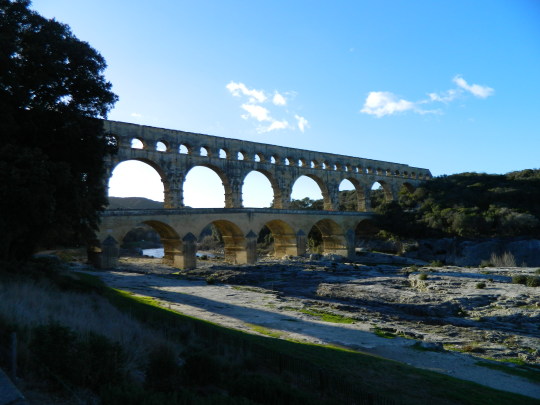
(The aqueduct of Pont du Gard, near Nimes...)

(...which we walked through!)
Well, that’s more than enough. If you are still reading, you’re probably my mom, so I here’s one more picture.
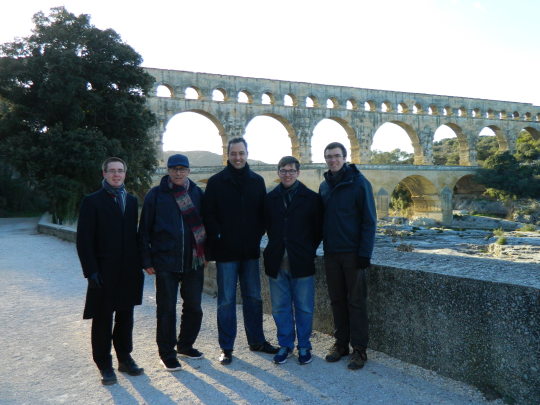
(All right, you can see my face!)
Exams await! Pray for me! God bless you all!
1 note
·
View note
Text
Our First Three Valentine’s Days
Steven and I have visited over 200 destination together. Our love for traveling has always been part of our relationship. After one week of dating we took a trip together from Boulder, CO to NYC. Every day since then over the past three years together have been an adventure making each year more special than the last.
Valentine’s Day 2014: Boulder, CO
Our first Valentine’s Day in 2014 was in Boulder and I was at work all day. Steven asked my boss if he was allowed to surprise me with a gift at work and she was happy to allow it, as long as it was at the end of the day. I was in the middle of working when Steven showed up with cupcakes, flowers and a huge panda bear, knowing I love pandas to death. It was my best Valentine’s Day up until then, and it is when I knew he was a keeper. It was not about the gift but the detail itself, he got my all favorite things: flowers, a panda and cupcakes!
He took me home and when I opened the door I see a huge “I LOVE YOU” written in roses petals and a delicious home cooked dinner, more gifts and cookies waiting for me.
My favorite thing was that after a long day at work I could spend some time relaxing and enjoying some delicious food with my boyfriend and my cats. Even the cookie said “I love you.”
Valentine’s Day 2015: Guayaquil, Ecuador
Our second Valentine’s Day in 2015 was in Guayaquil. It was not as exciting as our first Valentine’s, but we made sure to have a romantic day. We drove to the beach for the day and enjoyed a delicious meal and spent some time playing in the sand and the waves.
We watched the sunset over the water before heading back home. It was a delightful day where we got to spend some quality time together while getting away from our jobs and the city.
Valentine’s Day 2016: Zaragoza, Spain
Valentine’s Day 2016 was in Zaragoza, Spain. We celebrated my birthday and Valentines together. Steven planned a surprise trip for the weekend.
We explored Zaragoza during the day and at night Steven took me to a nice restaurant for dinner, with a three meal course and a wine toast. After dinner we were picked up by a limo at the restaurant to go on a tour around Zaragoza.
The limo was so much fun! We had bottle of Champagne and the tour included a camera so we could take photos of the adventures! We drove around the city while dancing to our favorite music.
The limo dropped us off at the hotel, which had a nice rooftop spa with a panoramic view of the city. The next day we enjoyed half the day at the spa, then we did what we loved the most: explored a new city together.
Valentine’s Day 2017: ?
We are not sure where this year will take us, but we are hoping to travel to Bolivia to visit the Uyuni Salt Flats and the Colorada Lagoon. Now, it is your turn and tell us more about your Valentine’s Day adventures!
The post Our First Three Valentine’s Days appeared first on Travel to Blank.
from Our First Three Valentine’s Days
0 notes
Text
# Food4Heroes, the altruistic idea that has already distributed four tons of food to health workers | New Times in EL PAÍS
When the state of alarm forced bars and restaurants across Spain to shut down, a group of catering businessmen realized something: what will health workers eat, forced to be at their jobs longer hours than ever? If they can't even go down to their hospital canteen to regain strength? The concern spread and a series of Madrid restaurateurs created, on March 16 (two days after all those businesses had to close), # Food4Heroes, an initiative to provide free lunch and dinner to these workers in the city from Madrid. “When we realized what the closure meant, it occurred to us to do what we do best: cook pizzas. We sent messages to acquaintances who work in hospitals to see what they needed and within a few hours we began to receive requests, both from health workers like other colleagues in the sector who wanted to collaborate, “says Hugo Rodríguez, founder of the Grosso Napoletano restaurant group and one of the promoters of the initiative, which has already joined more than 85 restaurants.
But crossing the streets to accomplish that purpose is complicated. Both traffic restrictions and the growth of Internet purchases are posing a logistical challenge for restaurateurs and delivery companies. For this reason, dozens of workers at the public company Correos have voluntarily collaborated as distributors of the project. “These postmen and wallets have decided to continue distributing in solidarity after even leaving work, which shows their great commitment to society and to all those people who are giving their all in hospitals,” explains a spokesman for the postal entity, which is also taking food to Zaragoza hospitals in collaboration with the #GastroAplausos initiative. In recent days, the mailbox of Grosso Napoletano has not stopped receiving messages of support and availability from individuals and companies that wanted to put their shoulders in some way. “It is incredible to see how people are joining. It is impressive to pick up the phone and to hear on the other side: 'Hello, Hugo, I am Juan Manuel Serrano, president of Correos. We are at your disposal'. This indicates that the idea has been transformed into a project for everyone, “stresses Rodríguez.
In the first 13 days, four tons of food have been distributed, according to the promoters of the idea. “The important thing is to note that each business contributes what it can, and that this is a lot. There are even individuals who call us to offer themselves as cooks in their houses to make different dishes, but we have to reject their good intentions because the food that is distributed is made with sanitary protocols, “says Rodríguez. At the moment, # Food4Heroes delivers food to 20 health centers, among which are the Gregorio Marañón, 12 de Octubre, La Paz, Ramón y Cajal, the Cínico San Carlos and the Jiménez Díaz Foundation hospitals. Grosso Napoletano has been joined by chains such as Tierra Burrito or restaurants and cafes such as La Miguiña, Bizzo Pizza or Brunch Club Café.
The coordination of # Food4Heroes
The success of this campaign lies in its effectiveness. To receive food, professionals who work in Madrid hospitals have to send an email to [email protected] to participate and send their needs. The restaurants, through a WhatsApp group (they already have five, one for each geographical area in which they have divided the city, due to the large area they must cover), contact them to explain what food they can bring them that day ( quantity, ingredients, etc.) and at what time will it arrive. Manuela Prado, 18 years old and Rodríguez's niece, is in charge of managing communication between hospitals and restaurants. “Their work is complex as many others are added to the general groups, one for each hospital, with the restoration workers. It is an example of how young people are also getting wet,” adds the founder of Grosso Napoletano.
Spanish hoteliers and health workers who want to be part of this initiative can write to [email protected] and the # Food4Heroes team will indicate the steps to follow
After this communication, Correos volunteers collect the food on the premises and deliver it to the workers of the centers, usually to the emergency doors and respecting the preventive measures established by the health protocols. “The idea is that this initiative extends to all the cities of Spain. And Correos will be there to continue collaborating,” says the parcel company. The initiative has also started in Barcelona, Pamplona, Murcia, Bilbao, Valencia and Malaga.
An activity that cannot stop
In addition to supporting the health service, the work of these postmen and delivery people connects families who, isolated in different cities, need this postal service for basic necessities. This has been one of the reasons why the postal company has decided, in accordance with the state of alarm, to continue offering its services. Although, with the aim of protecting the public and its workers, the public company is operating with the minimum essential personnel, who work alternate day shifts. Correos has modified the office hours, which will be open from 9:30 am to 12:30 pm, Monday through Friday; afternoon and Saturday deliveries have been suspended.
The form of delivery of notifications and shipments has also been modified: they will be left at the threshold of the address (or at the counter of the corresponding office), the data will be required from the recipient if necessary and without having to sign on the PDAs . “The entire network has gloves, gels and a mask, the maximum level of protection indicated by the Spanish health authorities, and protective screens have been installed in all Correos offices (4,500 throughout the country) in order to increase security of workers and protect their health, “says a company spokesman about its preventive measures, imposed since January 28 and which have intensified as the situation evolved. The services that are still available are national and international letter shipments of up to two kilos, postal packages of up to 20 kilos (known as the Blue Package), money orders, and certified and declared value services.
The post # Food4Heroes, the altruistic idea that has already distributed four tons of food to health workers | New Times in EL PAÍS appeared first on Cryptodictation.
from WordPress https://cryptodictation.com/2020/04/02/food4heroes-the-altruistic-idea-that-has-already-distributed-four-tons-of-food-to-health-workers-new-times-in-el-pais/
0 notes
Text
5 things to know about Cinco de Mayo
(CNN)Guacamole and fajitas. Mexican flags and mariachi bands. Margaritas, beer — and more beer. (Sometimes with lime, thanks to that clever marketing campaign.)
It’s May 5, and America is celebrating Cinco de Mayo — but why?
The Mexican holiday is still celebrated in Mexico, but the local tributes pale next to the giant celebration in the United States, complete with restaurant specials, high-volume advertising and endless promotion. Here are five things you should know about May 5.
1. It’s not Mexican Independence Day.
Cinco de Mayo celebrates the Mexican victory over France (of all countries) at the Battle of Puebla, May 5, 1862.
Mexico had been invaded by Spain, France and Great Britain in late 1861, but within six months Spain and Britain had pulled out. With the U.S. Civil War raging north of the Mexican border, the French decided to take advantage of the chaos and invade Mexico, which had been torn apart by war in the late 1850s.
The French made inroads in April 1862, but in May, at the town of Puebla — about 85 miles east of Mexico City — a small Mexican army under the command of Ignacio Zaragoza defeated a larger French contingent. It was a classic David-over-Goliath victory, and it’s been celebrated ever since for its symbolic value … even though the French did eventually take over Mexico and establish the short-lived Second Mexican Empire under the Emperor Maximilian.
Mexican Independence Day, incidentally, is celebrated September 16.
2. It’s got a Texas connection.
Zaragoza was born in what’s now Goliad, Texas, about 60 miles due north of Corpus Christi. In 1999, the Texas Senate declared it the official place to celebrate Cinco de Mayo.
And celebrate it does, with live music, ballet folklorico dancers and barbecue. There’s also a giant party at the Goliad Fairgrounds.
“It has opened the doors for Goliad. It is something that we are all very proud of. That’s one of the reasons we hope our youth will continue with the traditions,” former justice of the peace Emilio Vargas told the Victoria (Texas) Advocate in 2014.
3. It’s not just a big deal in the Southwest.
Among the best and most visited Cinco de Mayo festivals in the United States are held in Chicago (where the party in Douglas Park attracts 200,000), Denver (400,000 over two days), Portland, Oregon (the Waterfront Park festival attracts 300,000), and St. Paul, Minnesota.
St. Paul, Minnesota? Yes, indeed. The city includes a neighborhood known as the District del Sol, an area in the Minnesota capital’s west side that started attracting Mexican immigrants in the early 20th century. The Latino population now numbers more than 25,000 — close to 10% of the city, according to St. Paul Historical — and the Cinco de Mayo festival takes up two days.
4. Why so American?
Though Americans have been celebrating Cinco de Mayo practically since the battle ended — especially in the West — it was largely unknown in most parts of the U.S. until the 1960s, when Mexican-American activists started raising its profile. It’s become a way to celebrate pride in the community.
But, the United States being what it is, it’s also a great marketing opportunity. In 2014, Cinco de Mayo (or the nearest Friday, anyway) happened to be the biggest non-winter drinking day of the year, and it’s in the top five drinking holidays in general. Hey, you’ve got to have something to take the edge of the spicy food.
5. Have you considered mole poblano?
Speaking of food, don’t limit yourself to Taco Bell and nachos with refried beans. Puebla is actually one of Mexico’s best food cities, Smithsonian magazine observes, and its delicacies should be more widespread, especially on its most notable holiday.
So for Cinco de Mayo, the magazine recommends you sample the following: mole poblano, the chocolate-colored sauce that’s the city’s favorite dish; chalupas, thick tortillas with meat, salsa and onion; and chiles en nogada, fried peppers with walnut sauce, pomegranate seeds and parsley — which offers the colors of the Mexican flag.
Felices fiestas!
from All Of Beer http://allofbeer.com/5-things-to-know-about-cinco-de-mayo/ from All of Beer https://allofbeercom.tumblr.com/post/183302080932
0 notes
Text
5 things to know about Cinco de Mayo
(CNN)Guacamole and fajitas. Mexican flags and mariachi bands. Margaritas, beer — and more beer. (Sometimes with lime, thanks to that clever marketing campaign.)
It’s May 5, and America is celebrating Cinco de Mayo — but why?
The Mexican holiday is still celebrated in Mexico, but the local tributes pale next to the giant celebration in the United States, complete with restaurant specials, high-volume advertising and endless promotion. Here are five things you should know about May 5.
1. It’s not Mexican Independence Day.
Cinco de Mayo celebrates the Mexican victory over France (of all countries) at the Battle of Puebla, May 5, 1862.
Mexico had been invaded by Spain, France and Great Britain in late 1861, but within six months Spain and Britain had pulled out. With the U.S. Civil War raging north of the Mexican border, the French decided to take advantage of the chaos and invade Mexico, which had been torn apart by war in the late 1850s.
The French made inroads in April 1862, but in May, at the town of Puebla — about 85 miles east of Mexico City — a small Mexican army under the command of Ignacio Zaragoza defeated a larger French contingent. It was a classic David-over-Goliath victory, and it’s been celebrated ever since for its symbolic value … even though the French did eventually take over Mexico and establish the short-lived Second Mexican Empire under the Emperor Maximilian.
Mexican Independence Day, incidentally, is celebrated September 16.
2. It’s got a Texas connection.
Zaragoza was born in what’s now Goliad, Texas, about 60 miles due north of Corpus Christi. In 1999, the Texas Senate declared it the official place to celebrate Cinco de Mayo.
And celebrate it does, with live music, ballet folklorico dancers and barbecue. There’s also a giant party at the Goliad Fairgrounds.
“It has opened the doors for Goliad. It is something that we are all very proud of. That’s one of the reasons we hope our youth will continue with the traditions,” former justice of the peace Emilio Vargas told the Victoria (Texas) Advocate in 2014.
3. It’s not just a big deal in the Southwest.
Among the best and most visited Cinco de Mayo festivals in the United States are held in Chicago (where the party in Douglas Park attracts 200,000), Denver (400,000 over two days), Portland, Oregon (the Waterfront Park festival attracts 300,000), and St. Paul, Minnesota.
St. Paul, Minnesota? Yes, indeed. The city includes a neighborhood known as the District del Sol, an area in the Minnesota capital’s west side that started attracting Mexican immigrants in the early 20th century. The Latino population now numbers more than 25,000 — close to 10% of the city, according to St. Paul Historical — and the Cinco de Mayo festival takes up two days.
4. Why so American?
Though Americans have been celebrating Cinco de Mayo practically since the battle ended — especially in the West — it was largely unknown in most parts of the U.S. until the 1960s, when Mexican-American activists started raising its profile. It’s become a way to celebrate pride in the community.
But, the United States being what it is, it’s also a great marketing opportunity. In 2014, Cinco de Mayo (or the nearest Friday, anyway) happened to be the biggest non-winter drinking day of the year, and it’s in the top five drinking holidays in general. Hey, you’ve got to have something to take the edge of the spicy food.
5. Have you considered mole poblano?
Speaking of food, don’t limit yourself to Taco Bell and nachos with refried beans. Puebla is actually one of Mexico’s best food cities, Smithsonian magazine observes, and its delicacies should be more widespread, especially on its most notable holiday.
So for Cinco de Mayo, the magazine recommends you sample the following: mole poblano, the chocolate-colored sauce that’s the city’s favorite dish; chalupas, thick tortillas with meat, salsa and onion; and chiles en nogada, fried peppers with walnut sauce, pomegranate seeds and parsley — which offers the colors of the Mexican flag.
Felices fiestas!
from All Of Beer http://allofbeer.com/5-things-to-know-about-cinco-de-mayo/
0 notes
Text
Jorge Miroslav Jara Salas: Urban wineries: capital ventures | Matt Walls Wine Blog
When London’s first urban winery opened in 2013, I was cynical. But London Cru is still going strong, having since won multiple awards for its wines and gained listings in Michelin-starred restaurants. A second winery, Renegade Wines, opened in Bethnal Green in 2016 and a further two are opening in the capital this year. With fruit being sourced from as far afield as Spain and Italy, it’s a phenomenon that raises questions about the practicalities of making wine in this way, but also about how understanding a wine’s origin and broader context can affect how much you enjoy it. They sound gimmicky, but urban wineries could represent a turning point in UK wine culture.
Urban wineries have been popping up in cities around the US for at least 30 years. Renting some cheap space on the outskirts of a city to make wine can make sense, especially if you don’t own vineyards. You might be further from your sources of fruit, but these might change from year to year. And you have a ready market of thirsty winelovers on your doorstep.
Over the past ten years they’ve been popping up internationally in cities like Cape Town, Sydney and Paris. Winemaker and architect Javier Arizcuren owns the only modern urban winery in Rioja, but points out it’s nothing new: “In the seventeenth century there were more than 50 wineries in Logroño city centre, most of them in underground spaces under the houses,” he says. Making wine in cities may not be a novel phenomenon – but shipping grapes from one country to make wine in another certainly is.
Hard yards
“The problems come week by week rather than all together, but they’re all tackle-able,” says Warwick Smith, founder of Renegade Wines. They set up their small London winery and bar in railway arches two years ago, making Pinot Noir and Chardonnay grown in Lombardy, Sauvignon Blanc grown in Bordeaux and Bacchus grown in Herefordshire. “The financial model is very tough to make work,” he says, blaming high rents, London salaries and low volumes, “but London is a good place to do it – we’re close to English fruit and close to France… and you can keep fruit fresh for longer than you’d think.”
The fruit they buy from Italy and France is hand-picked, stacked in small crates and transported at 2 ̊ C in a refrigerated truck for between 24 and 36 hours. I can’t imagine any winemakers would choose to truck their grapes across the length of France if they didn’t need to, but Smith is adamant that “the fruit loses almost nothing,” and they don’t even need to add sulphur at this stage to help preserve it.
Gavin Monery helped set up and made the wines at London Cru before recently moving to Vagabond to help establish their winemaking arm in the new Battersea Power Station development. “The biggest problem is getting fruit,” he says. “There’s a lot for sale but most of it is shit… There’s a lot of driving around involved. I go out and dig a hole in the vineyard to see what’s there.” During his years at wine merchant Roberson (owner of London Cru) he did a dozen vintages around the world and got to know many top winemakers who have proved invaluable by introducing him to diligent growers.
He admits “it’s definitely a bit more expensive” compared to making wine in-situ but he benefits from top-of-the-range equipment that many small domaines lack. “We were whole-bunch pressing Chardonnay in a basket press direct to barrel,” he says, and using premium Chassin oak from Burgundy. “It’s a world’s best practice operation,” he says with pride, “and the wines are £15, not £50… Hand on heart, I don’t think you could find a better wine from the country of origin cheaper.”
Urban context
Having recently tasted a broad selection at 34 Mayfair (which has a side list dedicated to urban wines) it’s clear that it’s not just a gimmick: some urban wineries are making very good wines that are not overpriced. Those who have concentrated on the age-old combination of well-sourced fruit, talented winemaking and up-to-date equipment can still make excellent wine, even if it’s made a few hundred kilometres from the source of the fruit. But when I drink wines made in London from foreign fruit, no matter how delicious some of them are, it still feels like something is missing: they lack a consistent sense of origin and context.
The more you get into wine, the more you enjoy not just the liquid in your glass, but what’s around the wine. When I drink a Barbera from Piemonte, I enjoy the wine for itself, but it also shines a light on the other wines I’ve drunk from this region, it tells me about the producer’s style compared to their peers, about the country, region and perhaps even vineyard where it’s grown. When I drink a Barbera from Piemonte – but made in London – this context feels somehow diminished. Much as I can still enjoy the flavour, for me it still feels like an anomaly; a wine from AOC Nowhere.
But I’m not the average drinker, I’m a wine geek. In the UK we still suffer from a lot of anti-wine prejudice, and urban wineries might help us get over it. Removing a wine’s context might help people enjoy wine for what it is and start afresh. One man’s context is another man’s baggage.
Because of the high rents, another thing London wineries share is a need for some kind of hospitality side to the business, a bar or events space, to help them sell more wine and make ends meet. They also offer tours. For Monery it’s not just about making the stuff, “it’s about getting people into wine. For a lot of people, it connects a lot of dots; you can see the penny dropping when they get a fuller idea of how it’s made.”
New horizons
It might be the wines made from foreign-sourced fruit that gets the headlines, but all three London wineries currently in production have dabbled with English grapes. In fact, London Cru won a silver medal at the International Wine Challenge last year for their 2016 Bacchus – the highest-scoring 2016 Bacchus in the competition. This accolade, coupled with an undersized 2017 vintage across Europe, has encouraged them to focus more on English still wines.
Vagabond will be making some wines in-situ under a Vagabond umbrella brand, but will also make wine in London – starting with an English zero sulphur Pét Nat Reichensteiner (“I know, I sound crazy,” says Monery), followed by a Bacchus. Renegade are about to release a £100 Blanc de Noirs from Suffolk Pinot Noir and Pinot Meunier – they claim to have sold 550 out of 800 already.
Concentrating on English wine is a smart move. English drinkers are often happy to pay a premium for English wine. Proximity to source and a shared culture will give the wines that crucial sense of context that wines made from foreign-sourced wines lack. And unlike making French Chardonnay, making English Bacchus is something London wineries have proved they can do better than anyone else. This might sound like faint praise to some, but the wines are increasingly impressive.
Monery suggests that eventually London could support around a dozen urban wineries. I suspect he’s right, and I also believe that as the quality of English wine increases, and more recently-planted vineyards start producing fruit, most urban wineries will specialise in English wine. No doubt they’ll also spread outside of the capital. And as increasing numbers of people in the UK work in their own home-grown wine industry, and the wines become ever more widespread, this too will aid the gradual rehabilitation of UK drinkers’ attitudes to wine.
That London ever made wine from fruit trucked in from France, Spain and Italy might one day feel like just another bizarre footnote in London’s rich wine history. But for now at least, London’s urban wineries still do, so enjoy the moment. “We’re making very good gear,” says Cliff Roberson at London Cru with relish. And they are.
Seven wines from urban wineries to try
London
London Cru Charlotte Street Chardonnay 2015 (12.0%; London) Roberson, £14.99 (good value) 100% Chardonnay from near Carcassonne in southern France, wine made in London. Fermented in old French oak barrels, aged on lees. A Chardonnay with real precision and finesse that is better than many a Mâcon at this price. Pale colour, retaining a hint of green. Discrete nose; cashew oak and lemon skins, apple and white peach. Medium-bodied, with ripe, bright acidity. Good flow, harmonious and balance. Mildly saline, mineral finish; fresh and moreish. Impressive, and really drinkable. 90 points
London Cru Sydney Street Syrah 2015 (13.5%; London) Roberson, £14.99 100% Syrah from near Zaragoza in northwest Spain, wine made in London. Fermented with 30% whole bunches then aged in French oak barrels. A harmonious, refreshing and drinkable Syrah that’s not pretending to be Rhône, but that’s the closest style of Syrah that comes to mind (or perhaps contemporary South Africa). Blackberry, a touch of charcoal and some underlying herbal aromas. Satisfyingly tannic, good structural acidity, all leading to a medium-length finish. 89 points
Renegade Wines Chardonnay 2016 (14%; London) £20.00, Renegade Wines Also available at 34 Mayfair Restaurant, London 100% Chardonnay from Lombardy in northwest Italy, wine made in London. Fermented and aged in old French oak barrels. Deeply coloured. Rich apricot and peach aromas and a hint of wet dog. An intense and full-bodied style, a little oily on the palate with balanced acidity and slightly raised alcohol. 87 points
Paris
Les Vignerons Parisiens ‘Haussmann’ Syrah 2015 (13.5%, Paris) Available at 34 Mayfair Restaurant, London; £70 on the list 100% organic Syrah grown in Visan, Southern Rhône, wine made in Paris. One third aged in new French 600l oak barrels for 11 months. Fresh, bright violet aromas, slightly funky too, but with good intensity and energy on the palate. Medium-bodied, balanced acidity, fine tannins and a brisk mineral finish. Less dense and extracted than you might expect from a 100% Syrah from this part of the Rhône. 90 points
Les Vignerons Parisiens ‘AN68’ Grenache Blanc 2015 (14%; Paris) Available at 34 Mayfair Restaurant, London; £66 on the list 100% organic Grenache Blanc grown in Visan, Southern Rhône, wine made in Paris. More successfully fresh and lively than many Southern Rhônes in this vintage. Light floral, quince and raw cream aromas. Slightly oily in texture, rich and generous but well balanced with noticeable, well-integrated oak. 89 points
New York
The Red Hook Winery ‘Seneca Lake (Abe Schooner)’ Cabernet Franc 2013 (12.3%; New York) £38.00, The Old Bridge Wine Shop Also available at 34 Mayfair Restaurant, London 100% Cabernet Franc grown in the Finger Lakes, New York State, wine made in Brooklyn, New York by Abe Schooner of the Scholium Project. Matured in 70% old wood, 15% new French oak and 15% new Hungarian oak. Super fresh, detailed and delicious, this is an entirely successful and original expression of Cabernet Franc. Very fine in fruit and structure, mainly raspberry and redcurrant in aroma, with some strawberry, raspberry leaf and integrated oak spice. Light-bodied, balanced, sappy, and very, very drinkable. 93 points
Logroño, Rioja
Arizcuren Rioja Sologarnacha 2015 (15%; Rioja) £25.00, Sommelier’s Choice 100% Garnacha (Grenache) made in Javier Arizcuren’s winery in Logroño. 8 months in old American oak, then 2 months in new French oak. Such an elegant wine, real balance and class. Bright berry fruit on the nose with underlying vanilla, grilled toast and honey; aromatically this concentrates more on fruit than oak. Medium-bodied with a lovely sense of freshness, some dark plum notes on the palate and a refreshing saline edge. Firm acidity and sculpted superfine tannin. Medium length. A refreshingly drinkable and mineral Rioja than can be happily enjoyed without food. 92 points
First published on timatkin.com.
View Source
from Jorge Miroslav Jara Salas https://ift.tt/2L7mDSH via Fuente
0 notes
Text
My next and last stop on this trip was Barcelona!! We arrived late afternoon after a 5 hour bus ride from Zaragoza and we literally found our Airbnb, got some food from the local supermarket and just stayed inside as it was pouring rain and we were once again, completely knackered! Our first official morning in Barcelona, we went to a big, I’d say national park that was a couple of streets behind our Airbnb that was basically a small mountain! (I exaggerate but it was a big ass hill!)
VIEWS
VIEWS
VIEWS
The views of Barcelona were totally worth the mini-hike we did to get up there! It was a really warm day and the sun was beating down but it was worth it! After that, we walked down to another Park that is quite famous because of some of the key pieces in there by the Architect Gaudi.
It was really beautiful park with lots to see, just be warned that right now, a big piece of it is under construction for maintenance purposes, and, even though it is a public park, these parts do cost money to go into, I think from memory they sting you about 7 euro for students to go see. We didn’t pay to go in as it was under construction and we were trying to save money.
After the parks, we jumped on a metro to head to the waterfront, and we went to a shopping Centre on a pier for lunch and found a really nice Japanese restaurant (I know I know, Japanese food in Spain but tapas is expensive yo). After lunch, we walked down La Rambla, a major street in the city, on our way to see one of Gaudi’s buildings. On our way we came across the Mercat de la Boqueria, this was kind of like a Borough market type place that was filled with fresh fruit, juice, veg meat and even lollies! It was packed full of people and if you hit that up when you’re in Barcelona, make sure you have cash on you! We didn’t have much on us so we didn’t really get to buy anything again probably for the best because we were trying to save a little money)
After we walked past the Gaudi building we decided to head La Sagrada Familia. another PRO TIP: book this online at least 2 days ahead of time, especially if you’re heading there in spring/summer we went to go in when we arrived, and they told us I had sold out, so we thought okay we’ll go online and book it so we can go before our flight tomorrow! NOPE! The next was also pretty much booked out so BOOK AHEAD!!
La Sagrada Familia
She’s really big
Gaudi builing on Passeig de Gràcia
After that we headed back to our room as Harry wasn’t feeling well and wanted to lie down for the afternoon, I stayed for about an hour charged up my phone and what not, then headed back out to go to the beach! It was lovely, the water was a great temperature and it was so nice to once again lie in the sand and read a good book, one of my favourite things to do on a beach back home! I was there for about two hours bringing me to 6pm so I decided to head back and get some dinner. The next morning we flew back to Manchester and then got the train back to Hull!
Beach
Lord of Shadows
She loves a beach moment
Thus concludes my French and Spanish adventure! Next, I spend a week in Hull and then I head off again… stay tuned for the next location! (If you follow my Instagram you’d already know where it is) @madditranent is my Instagram BTW
So follow along as I travel and stumble through life!
Maddi xx
Next Stop; BARCELONA! My next and last stop on this trip was Barcelona!! We arrived late afternoon after a 5 hour bus ride from Zaragoza and we literally found our Airbnb, got some food from the local supermarket and just stayed inside as it was pouring rain and we were once again, completely knackered!
0 notes
Text
Interview: Triptides (ENG)

Triptides playing L’Écurie / Rock This Town Extrafine.
I remember going to l’Écurie last week- it was a really sunny day, which was great because it had been raining for weeks in Romandie. I like to think the guys from Triptides brought the L.A. sun with them when they arrived in Europe, because as soon as they left Geneva the sun was gone for another week. I especially liked their jokes and their efforts to learn French- Glenn actually has a pretty good level! Join us for a chat about their evolution as a band through the years, their new album Visitors and the song Flashing Before Your Eyes, how they choose visuals that fit the music, and more.
What do you guys think of this venue?
Dylan Sizemore: It’s nice and cosy, like a beautiful European cottage. We’re gonna rock the cottage! (laughs)
Glenn Brigman: It reminds me of a punk bar in America, sorta rock and roll, punk rock. But with good food… It’s almost like where Dylan used to work! He worked at a vegan restaurant in Indiana called the Owlery. It was kinda rock and roll, but clean and with good food…
Shaughnessy Starr: A lot of wood!
What’s your life like in L.A.?
Josh Menashe: We play a lot of music, I’d say most of our lives revolve around getting together and practicing- jamming, rehearsing, writing, recording… Most of the time, when we hang out it’s just because we’re making music and then we do something after you know. We all work separate jobs and stuff, but it’s just so we can afford to make music.
Yeah, I was going to ask you- do you manage to live off your music yet?
Josh: Not entirely, but that’s the goal.
Glenn: Dream big!
You have just released a new song, Flashing Before Your Eyes- what’s the story behind it?
Josh: It’s kinda like a psychedelic dream, or like a moment. It’s like your whole life flashing before your eyes within a moment. It could be before you die, or before something beautiful happens.
Glenn: We were inspired- we were calling it the 8 Miles High song first, like The Byrds’ 8 Miles High.
Josh: Yeah, it’s inspired by the Byrds- they have a song that have loosely inspired it.
Glenn: But then I think we took it to a different place with the organ and the mellotron, and then we produced it so it ended up nuts and not anything like the Byrds, and more like a psychedelic dream pop or whatever! (laughs) Something like that!

I also wanted to talk about the video for the song. It was made by Alfredo Lopez right?
Josh: Yeah, he’s a friend of ours in Los Angeles, and we actually met him through Levitation Room. He did their video too.
Glenn: He’s worked with some really great bands, he did our last video for Invitation off our last record, he did Levitation Room’s Crystal Ball video… He did Damage Bug, which is John Dwyer from Thee Oh Sees, and he’s working on an Ariel Pink video right now! He’s got a great eye, he’s a really great director.
I think his work really fits the genre! It all really fits with the music.
Glenn: I’m glad you think so! He’s also a really good friend of ours, so it’s really easy to just be like “do you want to work on our video?” and he’s like “yeah, what do you wanna do, what’s your budget? Okay, let’s do it!” And that’s it.
What are the pictures we see in the video? Are they archives?
Josh: They’re archives, yeah. You’ll have to ask Alfredo, I don’t know anything specific.
Glenn: I think he collects 8-mm film- he puts 8-mm film on his computer. We threw a bunch of songs and he immediately picked Flashing Before Your Eyes, it was his favorite. So he already had a vision for what he wanted the aesthetic and the vibe to be. So that was cool- he was almost stoked to work on it I think! So it worked out, and I think it comes through in the creation, it’s very on point. The lyrics have changes, he follows the groove and the jams with cool images.
That’s great! I feel like the visuals and the music naturally come together in your work!
Josh: Je fais de mon mieux ! (ndlr : I do my best!) Is that correct?
Yes! You waited for it! (laughs)
Glenn: Honestly, the visual side is hard for us sometimes. For Afterglow, we had the album done two years before we found the artwork for it! It’s hard for us to say, “we want x, y and z.”. It’s more like, “we want it to feel like this”. And then people make art, and we look at it and ask ourselves “is that it? Do they get it?” It was tough.
Josh: Personally, I know what I like with art, but I’m unable to make the visual art. I don’t have the visual artistic skills.
Glenn: And we’re not creative directors in the visual arts either. We’re not like “we want blues mixed with orange, and a swirl, with a bird…” (laughs)
(ndlr: Two girls ask if the table next to ours is free)
Glenn: C’est libre! Make sure that it’s in the interview.

I also wanted to talk about your music over the years- you have been making music for about 8 years now, and I think you really have defined your music style within this whole psychedelic genre. I think throughout your evolution, you really have stayed within that psychedelic spectrum.
Dylan: I think that when I joined the band- that’s when it started heading more in this psychedelic direction. My guitar has been kinda psychedelic- Obviously, it’s called Triptides. There was a blending between 60s psychedelia with a surf vibe. And when I started playing bass in the band - not because I started playing bass in the band, it just happened to be the time I joined – the music was focusing more on 60s and early 70s psychedelic stuff. More so than the first three albums, that were surfier.
Glenn: Josh and I were also into a lot of modern indie rock when we first met, like Beach House, Real Estate, Girls... But we were also into the 60s stuff, like Pink Floyd, the Beach Boys, the Beatles. I think that slowly, we started getting more into that 60s-70s stuff. And I think that there was a boom of really great indie rock stuff for a while, and then the boom sorta became people trying to copy that. We didn’t want to be part of people trying to copy people that were just making new music. So I think we were more inspired by the older stuff at that point you know.
Josh: Yeah, it wasn’t even a conscious decision. I feel like it organically happened that way-
Glenn: Organically! We got an organ! (laughs)
Josh: We didn’t even talk about it, it just came naturally.
Glenn: Our friend saw that 12-string electric guitar, and then I found a Farfisa organ on Craigslist. It all happened pretty fast, so by the time you had both of those things all the songs had Farfisa organ and a 12-string Rickenbacker sound. That’s a pretty genre-defining tone and sounds, or colours- whatever you want to call it.

I wanted to talk about Visitors as well, your new record that’s coming out next week. I just wanted to know the reason behind the title. Is it because you guys are visitors in Europe? (laughs)
Glenn: Well, one of the songs is called Visitors. And it’s about aliens, and it’s kind of a psychedelic trip, using aliens as a metaphor for psychedelia. But I don’t know, I think everyone is a visitor right? We’re all just here for a little while, and then we go away and no one knows why, and it’s interesting.
Dylan: It can be whatever you want! You can say “visitors”, and some people might think aliens, or some people might think like you “oh! It’s because they’re in Europe!”. It’s a universal word.
Glenn: Yeah, it’s not like the red door with a lion’s face on it you know? It’s not just a specific thing. It’s something more universal. And everyone can be like “I’m a visitor in college right now, so I’m really into this album!” or “I’m a visitor in France, as foreign exchange student!” or whatever.
Dylan: Or they’ll listen to the album and visit the music…
Shaun: Or maybe Triptides are visiting me and my record player right now!
Josh: We were visiting Geneva.
Yeah, you guys are visiting us!
Glenn: Yeah, and we’re visiting your blog!

Finally, if you could say something to the Triptides from 8 years ago, what would you tell them?
Glenn: Oh God!
Josh: Go to Europe sooner!
Glenn: I would say, use a little less reverb on the vocals.
Shaun: What would I tell you guys 8 years ago? (laughs) I didn’t even know them 8 years ago.
Glenn: We met Shaun 3 years ago.
Dylan: If I could tell you guys 8 years ago… Don’t go to college. (laughs)
Glenn: I studied Spanish and I haven’t done anything with it so… But we’re going to Spain soon! Barcelona, Zaragoza, Bilbao… all sorts of cool spots. We’ll see you in Spain. Peace and love!
https://www.facebook.com/Triptides/
0 notes
Video
youtube
[https://youtu.be/vLPu9cFEvkM] Welcome to Hotel Reina Petronila in Zaragoza, Spain (Europe). The best of Hotel Reina Petronila in Zaragoza. Common services available are wifi available in all areas. In the section of restaurant you can enjoy snack bar, bar and room service. For your rest, the establishment offers hammam, hot tub/jacuzzi, fitness/spa locker rooms, fitness centre and spa and wellness centre. With regard to the transfer we will find electric vehicle charging station, bicycle rental (additional charge) and accessible parking. For the reception we will be able to have 24-hour front desk, luggage storage, concierge service, tour desk, safety deposit box and newspapers. The cleaning of the facilities will include ironing service, dry cleaning, daily maid service and laundry. If you travel for business matters in the accommodation you have business centre, fax/photocopying and meeting/banquet facilities. We will be able to highlight other possibilities as family rooms, non-smoking rooms, air conditioning, heating, lift and facilities for disabled guests Book now cheaper in http://ift.tt/2C1tQv5 You can find more info in http://ift.tt/2E6alqY We hope you have a pleasant stay in Hotel Reina Petronila Other hotels in Zaragoza Hotel Palafox https://youtu.be/7OqoRIBxvGI Other hotels in Spain UR Mision de San Miguel https://youtu.be/04TGt-VskRc Can Mora de Dalt https://youtu.be/2UbQJz3PLoE La Posada del Altozano https://youtu.be/mxJNeLca244 Prinsotel La Pineda https://youtu.be/-PWcE6yiZx8 Hotel Ignacio https://youtu.be/9h1-qlqPl0A Hotel Rialto https://youtu.be/OKNHbBqg6mQ Marbella Inn https://youtu.be/fwpHOgcWCeA Hotel Miau https://youtu.be/snW71GeJ7W8 Be Live Experience Orotava https://youtu.be/o67qmXO6VMI Hotel Madrid https://youtu.be/eOgoE617L1o Novotel Barcelona Cornellà https://youtu.be/ANlAiiNWiu0 Hotel Can Faustino https://youtu.be/MU_gqGkn0Gc Globales America https://youtu.be/XzbzNK4vvio Hotel Colón https://youtu.be/l-FAP3_S0NY Hotel El Coto https://youtu.be/wTPDO5iN8-4 In these hotels you will be able to enjoy different facilities such as. We hope you have a pleasant stay in and we hope you enjoy our top 10 of the best hotels in All images used in this video are or have been provided by Booking. If you are the owner and do not want this video to appear, simply contact us. You can find us at http://ift.tt/2iPJ6Xr by World Hotel Video
0 notes
Text
The Art of Travel in Zaragoza, Spain – World Heritage, Legacy and Urban Revival
Nestled between Madrid and Barcelona, skipping a visit to Zaragoza en route means missing out on ones of Spain’s most artistic and underrated cities. I’m glad I got to jump off and explore on an AVE train journey from Tarragona to Madrid, feeling like I’d stumbled upon a Spanish secret.
The capital of mighty Aragon, Zaragoza is the gritty and urban mixed with the ancient and decadent, held together by a historical thread of architecture and art, and a heritage showcasing a continuous turnover of design and expression.
Mudejar Art
– UNESCO World Heritage Zaragoza
Native to Aragon, Mudejar art blends Islamic and Christian elements from a time during the 12th and 17th centuries when both faiths coexisted. A core part of Zaragoza’s architectural heritage, the sheer amount of Mudejar art earned it a UNESCO World Heritage title, with the Ajafería Palace being the most symbolic.
This 11th century medieval Islamic palace remains one of the most beautiful and important of all the sights in the city as well as the seat of the regional parliament. It’s an open museum of the residential structures of the Taifa kingdoms. By 1118, it became a Christian Palace and the residence of Aragonese monarchs, who added extra layers and extension to the existing design, as did the Catholic monarchs with the Throne Room in 1492. Modernisation into the fortress style we see today came in 1593. Each room is like a puzzle piece of this architectural timeline, and while it draws the crowds, it’s a place where you can easily get lost in its detail, most notably in one of the main halls with these mesmerising archways.
For those with a keen eye, it can be found all around the city. The Roman past is interlaced with Mudejar art like at the Lonja Market, or at the Parish Church of San Gil Abad – a Romanesque temple destroyed in 14th century to make way for the now Mudejar church. El Salvador Cathedral was built over the main mosque of the old Muslim city, where Mudejar art can be found on the outer wall of the parish chapel and the Church of Mary Magdalen is Mudejar in style with a tower and intricately patterned tiles.
Plaza del Pilar Display
– Zaragoza and the Discovery of the New World
One of its defining features of Zaragoza is the stunning Cathedral-Basilica of Our Lady of the Pillar – a Roman Catholic Church in the heart of the Plaza del Pilar (the largest of all in Spain).
It provides one of the best-elevated views over the multi-domed dreamscape and a better perspective on the artistic plaza and its water features. Controversial, but central to Aragon’s history, it’s here where you will see how the Fuente de la Hispanidad (fountain) is shaped like Latin America in reference (amongst other symbols) to Columbus – Ferninand II of Aragon being the monarch who commissioned him for the ‘discovery of the New World’.
A Design Legacy of 2,000 Years
– Roman Zaragoza
Zaragoza’s Roman legacy is mostly found in the many archaeological museums, preserving a prominent layer of the city’s design, even if modern elements built over them, like the San Pablo church that was built to replace the old Roman hermitage of San Blas. The Caesaraugusta Theatre Museum (Museo Del Teatro De Caesaraugusta) is one of the largest theatres of Roman Hispania that once held 6,000 spectators. Ruins from a market can be viewed at the Caesar Augustus Forum Museum and you can still view an 80 metre long section of the old roman walls.
Street Art & Regeneration
– Urban Zaragoza
We were able to wander beyond the opulent centre of Zaragoza, where there is an interesting contrast in its abundance of street art. It’s all a part of an annual urban regeneration drive, Festival Asalto (the International Festival of Urban Art), bringing an artistic new life to forgotten neighbourhoods.
Since it’s inception in 2005, the city has filled with over 70 artworks using mural, graffiti, templates, posters and installations as the medium of expression by local artists and groups. You can embark on a self-guided walking tour to find them all using the handy online map (a printed version is also available).
2008 Expo Architecture
– Modern Zaragoza
Ultra-modern architecture adds to the multi-layers of artistry here, which you can see showcased at the Zaragoza Expo Zone, constructed in 2008. My two favourite designs were the Alma del Ebro sculpture that stands outside the Congress Palace and made especially for this International Exhibition by Spanish sculptor Jaume Plensa, and the Bridge Pavilion designed by British-Iraqi architect Zaha Hadid.
Homage to Goya
– The Artistic Son of Zaragoza
In the home of Goya, it’s no wonder that art plays a central role in the city’s persona. The dedicated Goya Museum (housed within at the 16th-century Renaissance building, Calle Espoz y Mina 25) showcases works from 15th to 20th century, with rooms dedicated to Goya’s self-portraits and etchings – the only museum which has the entire six series on display.
Gastronomic Cultural Expression
– The Art of Cuisine in Zaragoza
Much like art, people are reinventing old recipes and adding modern twists to traditional establishments and food customs. Zaragoza’s restaurant and culinary establishments are filled with local produce, and the love for tapas lines every corner and alley, such in the El Tubo district known for attracting the hungry crowds and Plaza de Santa Marta for café culture.
Mixing old and new in the form true to our daily historical wandering, we attended a tapas workshop at the modern gastronomic space that is La Zarola, later followed by a masterclass of jamon carving by Félix Martínez at La Jamoneria (it’s not my forte, but eating it is) and a little indulgence of candied fruits and chocolates at the vintage 1856 confectionary shop, Fantoba.
Things to Know About Zaragoza:
Tarragona to Zaragoza is a mere 1 hour and 30 minutes journey on the train, landing you right in between Madrid and Barcelona. Zaragoza is also 90 minutes from Madrid by train and just under two hours from Barcelona.
If you are looking to visit a lot of museums and monuments, and make use of public transport, consider getting the Zaragoza Card. From €20 for 24 hours or €23 for 48 hours, you’ll have access to all major sites, buses and tram lines, as well as discounts for listed shops and restaurants.
How to Book a Renfe Train Ticket in Spain – AVE Guide
I have a full Spain by train AVE guide, with suggested routes and top tips for travelling around the country, but here’s some quick fix tips for planning your rail adventure.
You can book tickets via the Renfe website in English here, and specific high-speed network tickets here. All tickets have to be pre-booked (payable by Visa, Mastercard and Paypal), since you can’t turn up on the day and book at the station.
The AVE trains have nine classes if you count the overnight trains with sleeper/bed options, but there are two main ones to consider – Turista (a second class option with 2 x 2 seating rows) and Turista Plus, which is a little more spacious (with 2 x 1 seating rows). I travelled to each destination with a Turista ticket – comfortable and great value for money.
If you are looking to book a multi-stop trip, consider getting a ‘Spain Pass’. This means you can travel using just one ticket for the AVE and other long distance trains. You must reserve a seat before every trip, as limited space is assigned for Spain Pass holders.
The post The Art of Travel in Zaragoza, Spain – World Heritage, Legacy and Urban Revival appeared first on Borders Of Adventure.
via Travel Blogs http://ift.tt/2DYpgni
0 notes